Month: November 2023
Europe Is Starting To Get Competitive With New Launchers
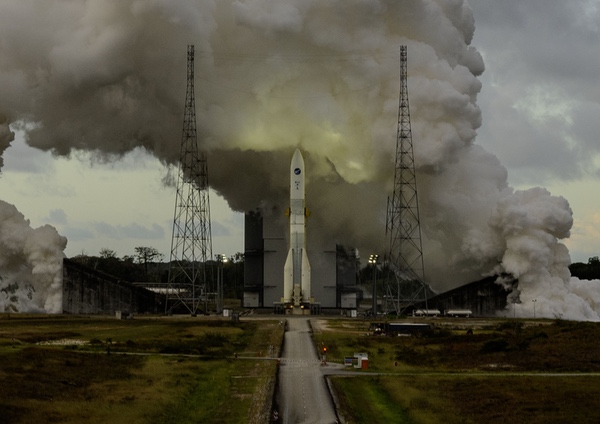 An Ariane 6 test model during a static-fire test November 23. ESA member states agreed earlier in the month to support that rocket while opening the door to future competition. (credit: ESA/M. Pedoussaut) An Ariane 6 test model during a static-fire test November 23. ESA member states agreed earlier in the month to support that rocket while opening the door to future competition. (credit: ESA/M. Pedoussaut) |
Europe turns to competition to improve its launch industry’s competitiveness
by Jeff Foust
Monday, November 27, 2023

European officials have acknowledged for months that the continent is in a “launcher crisis” caused by problems with new rockets like the Ariane 6 and Vega C (see “A crisis and an opportunity for European space access”, The Space Review July 10, 2023). But sometimes it seems like any mode of transportation in Europe is fraught with difficulty.
“I traveled by Deutsche Bahn. I was not sure that I could make it,” quipped Walther Pelzer, director general of the German Space Agency at DLR, in a keynote at Space Tech Expo Europe in Bremen, Germany, earlier this month, referring to the German rail operator.
He was followed by his French counterpart, Philippe Baptiste, CEO of the French space agency CNES. “I did not come by Deutsche Bahn. I came by Air France,” he said. “I’d rather not talk about it.”
| “We have to change how we procure the launchers of the future,” Aschbacher said at the briefing, embracing a launch services approach like that used in the United States. |
Both, though, did make it to Bremen, just as European officials traveled a week earlier to Seville, Spain, for a second European Space Summit involving member states of the European Space Agency and European Union. It was in Seville where ESA members agreed to a new launch strategy that would provide near-term support for Ariane 6 and Vega C while enabling far bigger changes to the long-term European launch landscape.
At the end of the ESA portion of the Space Summit November 6, agency officials announced an agreement to address current problems with Europe’s access to space. ESA will back what the agency called “stabilized exploitation” of Ariane 6 and Vega C, providing up to 340 million euros ($370 million) annually for Ariane 6 and 21 million euros ($23 million) annually for Vega C. That will go towards production of a set of 27 Ariane 6 and 17 Vega C rockets.
“This is very good news because we have a stable future for launchers in Europe of medium and large sizes,” said Josef Aschbacher, ESA’s director general, at a press conference after the summit. “This is a big relief, I can tell you, because a few days ago we did not have this situation yet.”
That decision affirmed the importance, in the near term, of both rockets despite their ongoing challenges. Ariane 6 was set to debut in 2020 but its first launch has been pushed back to some time in 2024 (an announcement about a more specific launch date could come as soon as this Thursday, after a successful long-duration static-fire test last week.) Vega C has been grounded since a December 2022 launch failure and is not expected to return to service before the fourth quarter of 2024.
However, ESA members also decided at the summit to open the door to other launch vehicles. They agreed to a competition or “challenge” program that would allow other launch providers to compete for an unspecified set of government missions starting later in the decade, rather than assigning them to either Ariane 6 or Vega C.
“We have to change how we procure the launchers of the future,” Aschbacher said at the briefing, embracing a launch services approach like that used in the United States. He called it a “paradigm shift,” a phrase repeated by many other European officials in the days and weeks after the summit.
| Competition, said CNES’s Baptiste, is “the only option for Europe to regain its position as a global space power.” |
However, ESA offered few details at the summit about how the competition would work: what companies would be eligible and what missions would be competed, among other details. An ESA spokesperson said last week that details about the proposed competition will be developed next year, with a goal of presenting a program that ESA members would fund at the next triennial ministerial conference in 2025. The potential missions, the spokesperson said, would be identified by ESA along with the European Commission, weather satellite operator Eumetsat, and national governments.
At Space Tech Expo Europe a week after the Space Summit, industry and government officials supported that new launch competition strategy despite a lack of details. “Competition will be the method of choice in the launcher sector in the future,” said Pelzer, noting that Germany advocated for a launcher challenge at an ESA meeting earlier in the year. “Monopolies imply a lot of risks.”
“We collectively agreed that the new model, resting on competition and service procurement, will frame Europe’s launcher and, most likely, low orbit landscape in the future,” said CNES’s Baptiste. “It’s the only option for Europe to regain its position as a global space power.”
Some European launch startups at the conference also backed the concept of a competition. “The Space Summit was an inflection point for the space industry in Europe,” said Ezequiel Sánchez, executive president of PLD Space. That Spanish company that performed a successful suborbital launch of its Miura 1 rocket in October and is working on the Miura 5 small launch vehicle, set to begin launches as soon as 2025.
“Our perception is that it is a clear opportunity for small launchers,” he said. “It’s very good news.”
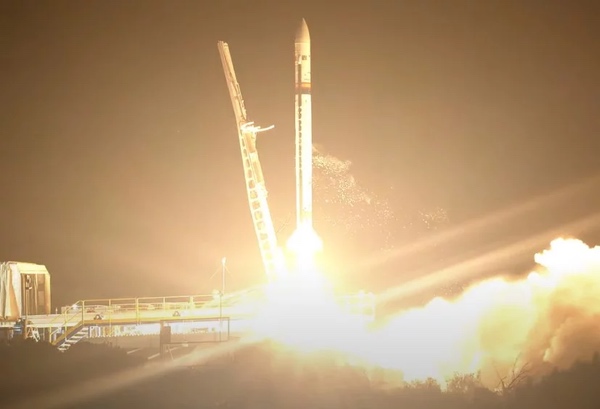 Spanish launch startup PLD Space launched its Miura 1 suborbital rocket in October as a test for its larger Miura 5 orbital launch vehicle. (credit: PLD Space) Spanish launch startup PLD Space launched its Miura 1 suborbital rocket in October as a test for its larger Miura 5 orbital launch vehicle. (credit: PLD Space) |
He appeared on a panel with Alan Thompson, head of government affairs for Skyrora, a UK-based small launch vehicle developer. Asked about the Space Summit, he curiously did not mention the launch competition plans announced there, taking a more pessimistic view. “We as a company have tempered our ambitions in terms of number of launches,” he said. The company has projected preforming up a dozen launches a year, “but looking at whether that is realistic, the answer is probably not.”
Others at the conference had other concerns about the competition, including exactly what missions would be included and how many. European launch startups have focused on small launch vehicles, placing up to a ton in low Earth orbit, but some have plans to grow to larger vehicles that might compete more directly with Vega C or even Ariane 6.
The demand for larger vehicles, though, is limited in Europe given the small number of government missions. The agreement at the Space Summit also committed European governments to buying at least four Ariane 6 and three Vega C launches a year.
“We can play with that, at least for small launchers,” Baptiste said of competition. “If we are talking about heavy launchers, I think it will be much more difficult.”
| “It cannot be that you have part of the industry having to run 100 meters with a 20-kilo backpack and others which have nothing,” said ArianeGroup’s Godart. |
The limited government demand would hinder any competition for larger rockets, noted Marco Fuchs, CEO of OHB, the German aerospace company that is backing small launch vehicle startup Rocket Factory Augsburg. “If you only have four institutional missions, you don’t need ten large rockets in Europe. That’s pretty obvious.”
ArianeGroup, the prime contractor for the Ariane 6, has its own concerns about the proposed competition. “Europe needs to get sorted on how it organizes this competition,” said Pierre Godart, CEO of ArianeGroup Germany. “We have a little bit of time, but not too much.”
He suggested that Europe not simply copy the launch competitions used by the U.S. government. “It’s never successful when we make a one-to-one copy,” he said. “We will have to find our European way forward, which is different from what we had in the past.” He didn’t elaborate, though, on what that “European way” would look like.
Whatever competition that does emerge, he said, needs to treat both incumbents and newcomers the same. “It cannot be that you have part of the industry having to run 100 meters with a 20-kilo backpack and others which have nothing,” he said.
That could include revisiting one of the central tenets of ESA contracting, the concept of geographic return or georeturn. Under georeturn, member states that subscribe to programs are guaranteed contracts in proportion to their contributions.
That approach, critics argue, makes it difficult for current European launch vehicles to be cost competitive, and would be even more difficult to implement in a future launch competition where there are no guarantees what vehicles from what countries would win government contracts for launchers.
“We have to reduce costs. We are ready to simplify as much as possible the complex system in which we live,” said Baptiste, who said that some Ariane 6 suppliers, guaranteed work because of georeturn policies, have increased their prices by up to 60%. “We can get rid of some part of the georeturn, at least for the exploitation of the Ariane 6.”
“I cannot choose my supplier. It is decided,” Godart said, referring to georeturn. “Even if I have suppliers who are not performing, I cannot change them.”
However, there seemed little appetite at the conference for broader changes in georeturn policies, with some officials expressing concerns that, without it, many countries might be reticent to subscribe to ESA programs. “If we want to crash ESA, getting rid of georeturn would be the best way,” said DLR’s Pelzer.
Géraldine Naja, ESA’s director of commercialization, industry, and procurement, acknowledged in a presentation at Space Tech Expo Europe the concerns about georeturn and how it might be applied to future launch competitions, saying only that the agency was looking is how it might “evolve” that policy. “It must be in the direction of good competition and good competitiveness,” she said.
Even with all the uncertainties about how a launch competition might be organized, there was general support for the concept because of the need to revitalize a launch industry that, in Europe, is lagging counterparts in America and China.
“I think Seville has been a great success,” said Sabine von der Recke, a member of the board of OHB who also is on the management team for the German Offshore Spaceport Alliance, a venture developing a sea-based platform for small launch vehicles. She cited both the support for Ariane 6—for which OHB is a major supplier—as well as the proposed future competition.
“Seville was not only a decision on launchers. It will change also the rest of space, because it’s the hardest decision and the most political,” she said.
Meanwhile, many of those who remained through the end of the three-day Space Tech Expo Europe conference found their travel plans from Bremen upended by disruptions to Deutsche Bahn’s schedule caused by a strike. Perhaps space will be an easier transportation challenge to solve.
Jeff Foust (jeff@thespacereview.com) is the editor and publisher of The Space Review, and a senior staff writer with SpaceNews. He also operates the Spacetoday.net web site. Views and opinions expressed in this article are those of the author alone.
Oxygen On Mars
 Terraformed Mars being greened with a nitrogen-oxygen atmosphere. (credit: Kevin Gill) Terraformed Mars being greened with a nitrogen-oxygen atmosphere. (credit: Kevin Gill) |
Oxygen for Mars
by John K. Strickland
Monday, November 27, 2023

There is a lot of attention in our community on creating a backup location for humanity and, along with pressurized in-space settlements, Mars is one of the best locations for that. But along with the human race and its civilization, we should also include the important requirement that we need a backup for life itself. Right now the only place known where life exists, and can survive and grow, is Earth, just one tiny planet. Our lives are enabled and enriched by the incredible variety of animals and plants that live on Earth, on land and in the seas. We would be immensely impoverished if all we had kept alive in space were the most critical plant species that we grow for food. So we need to think more about how to keep a whole biosphere alive.
In a 2015 article, Don Barker made one of the best statements in support of Mars settlement I have seen, and he mentioned a “backup for life on Earth”:
“The settlement of Mars is probably the most viable endeavor that would create a backup for life on Earth, in effect a global-mitosis. Mars is the only destination whose environment and accessible natural resources efficiently enable permanent and sustainable human habitation off Earth.” — “The Mars Imperative”, Barker, Donald C., Volume 107, Acta Astronautica 3-2015.
What is really needed is to create a habitat that is very large, one that has the physical land surface area equivalent to the outdoors on Earth instead of just pressurized habitats. To match some level of open space for significant numbers (breeding populations) of even a few thousands species would require dozens or hundreds of very large, dedicated artificial habitats in space. I hope such habitats can be built, and such habitats can serve as interim refuges, but having a fully terraformed planet where the animals and plants can live in the vastly larger space outside of habitats is very important. That requires terraforming Mars, the only planet in our solar system where terraforming will be practical without “magic physics.”
| For practical terraforming efforts of almost any kind, there are two basic requirements: large scale access to space and the destinations in it, and some form of fusion energy for power and propulsion. |
Some people criticize discussions of terraforming as “grandiose” or a “display of hubris” and being at an “industrial-scale,” faintly echoing the “Small is Beautiful” movement of 40 years ago. If you are trying to modify an entire planet’s atmosphere, the scale is by necessity “grandiose.” These anti-tech attitudes remind me of the desperate attempts by radicals to stop the California Condor captive breeding program. It seemed as if the radicals would rather have had the condors go extinct than allow a practical human effort to save a species to succeed. That program has resulted in a huge increase from 22 condors in 1982 to 540 in 2023, an almost 25-fold increase in just 41 years.
The same kind of values are being pitted against each other here, but on a vastly larger scale: the preservation of a major part of the vast diversity of life itself versus keeping the status quo for dead rocks on what currently is probably a lifeless and desolate planet. Even if there were living microbes deep under the surface of Mars, the value of millions of multicellular species would surely outweigh the value of microbes.
I have already covered the issue of how to provide the bulk of air pressure needed to terraform Mars (see “Rethinking the Mars terraforming debate”, The Space Review August 20, 2018). That article describes how huge amounts of solid nitrogen can be moved from Pluto or other locations and dumped into the Martian atmosphere with no cratering. This would allow rain to fall and liquid water to flow on Mars. Several people have suggested Venus as a closer source of nitrogen, but it is at the bottom of a deep gravity well, and would have to be skimmed off the top of the atmosphere, separated from the carbon dioxide and liquefied for shipment to Mars with a significant delta-V value. Pluto has a shallow gravity well and the nitrogen is already in solid form, and thus much easier to mine and ship in bulk.
The two things we need for full terraforming of Mars are nitrogen pressure and some oxygen pressure. Only anaerobic bacteria could live on Mars without oxygen. Therefore, Mars also needs oxygen.
For practical terraforming efforts of almost any kind, there are two basic requirements: large scale access to space and the destinations in it, and some form of fusion energy for power and propulsion. We should soon have the first, and things are looking promising to have the second. Without fusion, both terraforming and interstellar travel would be almost impossible. Since fusion occurs in nature inside every star, it is not magic physics. The huge amounts of fusion energy needed to transport the nitrogen to Mars and create the oxygen on Mars are comparable.
Wanted: 880 trillion tons of oxygen gas to support plant and animal Earth life on Mars. This amount would provide an average of three pounds per square inch (psi) of partial oxygen pressure for the whole planet. This is the normal sea level amount of oxygen we breathe, since most of the rest of the 14.7 psi we breathe on Earth is nitrogen. About the highest people can function is at about 5,200 meters (17,000 feet), where the oxygen pressure is about 40% of sea level, or about 1.2 psi, and those people are very highly adapted. Some people get altitude sickness at only 2,700 meters (9,000 feet), where the oxygen pressure is 70% of sea level or 2.1 psi partial pressure.
How do we know how much oxygen it would take to oxygenate a whole planet? Mars has 144.8 million square kilometers of surface, and each square kilometer covers one million square meters. The nitrogen pressure must always be several times higher than the oxygen pressure to prevent a runaway oxygen fire.
There are at least three ways to measure the amount of oxygen needed on Mars: pressure per square inch, pressure per square meter, or mass per square meter (which means all of the oxygen in the “air column” directly above each square meter, measured from the surface to the top of the atmosphere.) To provide 3 psi of oxygen air pressure on Mars, with its lower gravity, takes about 2.1 (Mars) tons of oxygen pressure per square meter or 2.1 million tons per square kilometer. But since Mars gravity is about 0.376 of a G, you would need 2.66 times more oxygen to get the needed pressure, or about 5.59 actual tons above each square meter of surface. The 2.1 tons per square meter is also the amount of oxygen pressure you would get on Mars. If Mars had the same gravity as Earth, you would need only 304 trillion tons of oxygen. So if each square kilometer needs 5.59 million tons of oxygen, Mars needs 5.59 million tons times 144.8 million square kilometers, which equals about 810 trillion tons of oxygen.
In nature, oxygen is a strongly reactive element like fluorine and “wants” to combine with other elements to create compounds like water. Thus there are no oxygen mines in nature, unless you want to rob Earth’s biologically-created atmosphere of a significant part of its oxygen. So the oxygen must be chemically created from an oxygen compound like water.
In fact, Mars has many thousands of cubic kilometers of water ice, each containing one billion tons or one billion cubic meters of water ice. If we have on Mars at least one million cubic kilometers of water ice, a volume of ice regolith or glacier 1,000 by 1,000 by 1 kilometer deep, that amount would contain 1,000 trillion tons or 1 quadrillion tons of ice. If this is pure ice, it would be under an area of one million square kilometers. (Mars actually has about 145 surface areas this large.) The 1,000 trillion tons of ice can be converted to 880 trillion tons of oxygen and 120 trillion tons of hydrogen via hydrolysis, exceeding the desired amount of oxygen by about 10%.
If there turns out to be less than the needed amount of water ice on Mars, massive amounts can also be imported from the abundant “iceteroids” (asteroids mostly made of ice.) Once we have fusion power, we should be able to provide energy in the extremely large amounts needed to provide Mars with the needed oxygen. Along with the imported nitrogen, this will allow full terraforming of Mars.
Water electrolysis (using the alkaline electrolysis method) has an effective electrical efficiency of 70–80% and produces one kilogram of hydrogen and about nine kilograms of oxygen from ten kilograms of water ice. This requires 50,000–55,000 watt-hours (180–200 megajoules) of electricity. Using the same method, it takes five megawatt-hours to electrolyze one metric ton of water.
| Mars has many thousands of cubic kilometers of water ice, each containing one billion tons or one billion cubic meters of water ice. |
To electrolyze that one metric ton of water takes 6,300,000 watt-hours using the PEM (Proton Exchange Membrane) method as used on the International Space Station (based on information from the Hydrogen Based Energy Conversion Handbook). This is a difference of almost 20%. (Note that I am using the higher PEM value here.) Since the ratio, by mass, of hydrogen to oxygen is 2:16, then oxygen is 16/18 = 8/9ths of a given unit mass of water. Therefore ,there are about 888 kilograms of oxygen and about 112 kilogram of hydrogen in 1 metric ton of water.
The Mars water ice input requirement to generate 3 psi of oxygen is 1,000 trillion tons or 1 quadrillion metric tons. The required ice volume would be about 1,000 by 1,000 by 1 kilometer deep. The hydrolysis plant is assumed to have an efficiency of about 71%. Production numbers are based on the use of about 6,300 kilowatt-hours or 6.3 megawatt-hours to electrolyze one metric ton of water as above. Condensing the vast bulk of the resulting gas into cryogenic liquids is not needed, but I will assume that the plant would use 7.0 megawatt-hours for each ton of water to allow about an 11% margin.
Here is a scale-up table showing energy use and mass for hydrolysis of different amounts of water ice. Each line or row has 1,000 times (three orders of magnitude) more of mass and energy use than the last. Most people are not even familiar with the names of amounts of energy this large.
| Energy use (amounts) | Water ice mass | Oxygen Mass | Hydrogen Mass |
|---|---|---|---|
| 7 watt-hours | 1 gram | 0.88 grams | 0.12 g |
| 7 kilowatt-hours | 1 kilogram | 0.88 kg | 0.12 kg |
| 7 megawatt-hours | 1 metric ton | 0.88 tons | 0.12 ton |
| 7 gigawatt-hours | 1 thousand tons | 880 tons | 120 tons |
| 7 terawatt-hours | 1 million tons | 880,000 tons | 120,000 tons |
| 7 petawatt-hours | 1 billion tons | 880 million tons | 120 million tons |
| 7 exawatt-hours | 1 trillion tons | 880 billion tons | 120 billion tons |
| 7 zettawatt-hours | 1 quadrillion tons | 880 trillion tons | 120 trillion tons |
The last row in italics shows the quantities we actually need to deal with.
The extra 8–10% (80 trillion tons) of oxygen would possibly be absorbed by the surface rocks and regolith after billions of years of exposure to a near vacuum had reduced the oxygen pressure and molecular rock surface saturation levels to effectively zero.
So, over what time scale is it reasonable to expend the seven zettawatt-hours of energy? To split this up into manageable sized components, we could start arbitrarily with 7,000 plants, each one of which would expend “‘only” 1 exawatt-hour during the operational period. This large set of installations could be named the Edgar Rice Burroughs Oxygen Production System or ERB-OPS, since he described a huge “atmosphere plant” existing on Mars in his famous Barsoom stories written about a century ago. This plan assumes we can eventually build very large fusion power plants.
So, over what time scale is it reasonable for each plant to each expend its 1 exawatt-hour of energy? The larger portion of the full, breathable air pressure on Mars should be able to be recreated in about 150–200 years via the simultaneous import of nitrogen from the outer solar system. If we set the operational E.R. Burroughs oxygen plant project period at 200 years, each plant would need to expend five petawatt-hours per Earth year. (one exawatt-hours / 200 = five petawatt-hours). The exact time period is not terribly critical and would be based on future decisions about the cost and very large scale of the terraforming operation.
Since each Earth year has 8,766 hours, the energy at each plant needs to be expended at a rate of 5,000,000,000,000,000 / 8766 = ~570,400,000,000 watt-hours or 570.4 gigawatt-hours per hour, or a power level or rate of 570.4 gigawatts. During full-scale operation of the Burroughs installation, all 7,000 plants, running at 570.4 gigawatts per hour, would be expending just about 4,000 terawatts or four petawatts. (Due to the high range of magnitudes in the calculation, the single plant rate should be between 570.4 and 571.5 gigawatts).
If all humanity is currently using about 20 terawatts or 20,000 gigawatts, the level of power from one Burroughs plant would be at the same level as about 1/35th of all current human energy production (570 / 20,000 = 0.0285), while the total Burroughs system power level would about 200 times larger than all of current human energy production and use (4,000 /20 = 200). For another comparison, the Earth receives, as a constant rate, 174,000 terawatts of solar energy on is sunward side. About 122,000 terawatts of this (122 petawatts per hour) reaches the surface and lower atmosphere. For every 24 hours, the Earth thus receives 2,923,000 terawatt-hours from the Sun. So the Burroughs system would be generating and using power equivalent to about 3% of the sunlight the entire sunlit side of the Earth gets.
In the table below, all measurements are in either terawatts (1,000 gigawatts) or terawatt-hours. For example, North America uses an electrical power rate of several terawatts. So each plant would be producing power at a rate about 1/10th of that or about 500 times more than a typical one-gigawatt power plant. Each plant of course can exist as a set of ten, 50 gigawatt plants close together.
| System: | Sun to Earth | Burroughs system | 1 Burroughs plant | Mankind 2023 |
|---|---|---|---|---|
| Power Level | 122,000 terawatts | 4,000 terawatts | 0.570 terawatts | ~20 terawatts |
| Amount/Day | 2,923,000 TWH | 96,000 TWH | 13,680 TWH | 480 TWH |
| Amount/Year | 1,069,000,000 TWH | 35,634,000 TWH | 5000 TWH | 175,320 TWH |
| Amt /200 Yrs | 213,890,000,000 TWH | 7,012,800,000 TWH | 1,000,000 TWH | 35,064,000 TWH |
You would think this might overheat the whole planet, but an area on Mars only gets half of the sunlight Earth gets, so even if the heat was distributed over the whole planet evenly, Mars would not cook. To even be as warm as the Earth is without added greenhouse gases, it would need to get about 26,000 terawatts of sunlight on its quarter-Earth-size sunward face, while it currently gets only about 18,000 terawatts. The areas being mined for water ice and supporting the plants would amount to about 1/145 of the surface, or one million square kilometers out of 144.8 million square kilometers. In practice, the equipment to build the plants would build them serially, moving from site to site, so that they would all come on-line over a period of decades.
Such high levels of energy use could only be practically supplied by fusion power. We also assume that these fusion plants will be able to be scaled up from a single city size (one to five gigawatts) to produce the most efficient size of fusion reactor, so that the power from one or several reactors can be distributed to the multiple hydrolysis plants surrounding each reactor using the least amount of power cable and associated mass. It is hoped that a form of aneutronic (no neutrons) fusion, such as boron-hydrogen fusion, will be available when the plants are designed.
| The time period for reaching a breathable oxygen/nitrogen atmosphere on Mars can be less than it took for some Gothic cathedrals to be built. |
Efficient design of the fusion plants and hydrolysis plants can also reduce the amount of heat released. Early work is currently ongoing to try to generate power directly from the fusion process itself, so that there would not have to be a standard heat engine with turbine generating power at each plant. In addition, the electrolysis process used here as the main example may be able to be improved massively, not simply by improving liquid hydrolysis, but possibly using super-critical temperature electrolysis, steam electrolysis, catalytic electrolysis, or other advanced methods. So the total power requirement may be much less than the values given here for the scale-up of a standard system. There are also different methods used for liquid hydrolysis. Some use proton exchange membranes and others use added electrolytes such as sodium and sulfur to allow the electric current to move through the water from one electrode to another. Mars has plenty of both sodium and sulfur. Unfortunately, there are few sources that can give us a clue on how much the future energy savings might be. In a future of abundant energy, the design effort would not be to just reduce energy use, but to reduce the amount of materials used and potentially to reduce the scale of the effort.
Assume that the ice layer areas are being mined to an average of about one kilometer deep at plant locations, with one billion metric tons of ice under each square kilometer. If the ice layer is not pure ice, the final excavation layer would be deeper or larger. The operational mode would probably be similar to that for a surface mine for copper or iron, looking like a concentric set of circles, and preventing too steep a slope in the work area during mining operations. With shallower ice deposits or those with layers of gravel, the total area would be wider. The fusion and hydrolysis plants would be located on nearby areas that are not mined, preferably those with little or no ice under them. Crew quarters would be almost entirely underground for thermal and radiation protection. Crews would have access to the plants via pressurized tunnels and control rooms. The oxygen produced would be released directly into the atmosphere, and would possibly be able to carry some or most of any waste heat quickly up and away from the industrial sites. Significant amounts of the hydrogen from plants closer to settlements would go through pipelines to be used as rocket propellant or as feedstock for making methane.
Of the total of one million cubic kilometers of water ice, each of the 7,000 fusion and hydrolysis plants would process a total of about 143 cubic kilometers of ice, or a total of 0.715 cubic kilometer (715 million tons of ice) per year. Such a mining system would cover about 1/145th of the total area of Mars (which is 144.8 million square kilometers), probably spread around the sub-polar areas in a circle so we do not disturb the layered ice deposits there right away. At the end of the operational electrolysis period, the hydrolysis plants, covering a small fraction of each process area, would be converted to other uses and the land area freed up. If the ancient Borealic Ocean is replaced eventually, the excavated areas would have deeper water and there should also be some deep basins around the South Pole.
If both nitrogen transfer and oxygen generation start to take place, we need to understand how life would slowly start to take hold on the surface of Mars. Currently, with no liquid water possible on the surface due to the very low pressure, (effectively a physiological vacuum), with constant cosmic radiation and ultraviolet radiation and with virtually all the water on Mars frozen, there are probably no active life processes occurring on or near the surface.
If we assume that Mars has been warmed enough by terraforming efforts to sublime the remaining 25 trillion tons of dry ice at the south pole of Mars, doubling the amount in the atmosphere to 50 trillion tons, this alone would raise the boiling point of water to about 7 degrees Celsius., allowing liquid water in small areas at lower elevations. It would also raise the carbon dioxide pressure level to about 1.2 millibars average from the current 0.7 millibars. Current carbon dioxide levels on Earth are about half a millibar or 0.42 parts per thousand. For breathing, carbon dioxide should be no more than about one part per thousand or one millibar in an atmosphere, but the 20% extra carbon dioxide pressure should cause no problems.
By the time we have added ten times this amount of nitrogen or 500 trillion tons, water could be a liquid at many elevations, allowing clouds to form and rain would probably fall. With some rain, the dust would slowly be washed out of the air, and streams and rivers would start flowing. The sky would gradually turn from creamy-tan to a very dark blue. The rain would start to wash the perchlorates out of the regolith and eventually into the Borealic Ocean. Since the amounts of perchlorates in the regolith could be as high as 1%, this could take a while. Until the bacteria species that can digest the perchlorates (such as some in the genera Dechloromonas and Azospira), are introduced into each stream or river, cyanobacteria would not be able to grow there. Spores of bacteria may be able to be widely introduced by the wind, so that the headwaters of most streams would receive some of them. If the species that can metabolize perchlorates do not form spores, we may be able to give them that capability via genetic engineering by the time terraforming starts.
Currently free oxygen is present in only tiny trace amounts on Mars. Oxygen-fed fires of any kind cannot even burn at partial pressure levels below about 2.25 psi or (71% of Earth partial oxygen pressure). Until oxygen is added, only anaerobic organisms like the botulism bacteria could grow. Also, blue-green algae (or cyanobacteria) would start growing right away in any bodies of water in any that have been cleared of perchlorates as they do not need oxygen to survive. (Most of these organisms would be aquatic.)
Once you can add some significant amounts of oxygen, some kinds of low-oxygen organisms could also grow. The more you add, the more kinds of organisms could grow. Initially, most of these would be aerobic bacteria and single cell eukaryotic algae, as each individual cell is in direct contact with the oxygen dissolved in the water. The minimum level is at least 10% of current oxygen levels or about 0.3 psi in the air. Multicellular animals would probably need at least one-third of current levels or about one psi of oxygen. For small aquatic animals with circulatory systems you might need at least two psi of oxygen, since the animals cells are not in direct contact with the ocean water. For larger animals like fish and amphibians, you would probably need at least 2.5 psi. Animals and fish would not be introduced until there was sufficient plant or algae growth to sustain them.
Most of the early Earth animal models studied for tolerance to low oxygen levels were aquatic, so it is harder to determine the needed levels for land animals. Since many animals live out of water, their lungs would have direct access to the oxygen in the air even though their cells depend on the circulation of blood. All of these obviously have circulatory systems, so any active animals would probably need at least 2.0 psi of oxygen.
Green plants probably require at least 50% of current oxygen levels or about 1.5 psi of oxygen partial pressure compared to today’s sea level oxygen partial pressure of 3.0 psi. Advanced plant roots get less oxygen underground so vascular plants might need 2.0 psi. So the visible greening of Mars would initially be a slow process, speeding up after oxygen levels reached 2.0 psi.
Before anyone should consider starting such a large-scale process, there are a number of provisos and conditions that should be met:
- The human economy in the Solar System and/or on Mars must be large enough to support the effort.
- The cost over the construction period would need to be accurately estimated.
- There must be some level of public or private support.
- Construction of the equipment can take place over a multi-decade period of time.
- Replicator systems would greatly reduce cost for the system, so the timing of the start of the operation is important.
- Sources and levels of heat emission at the fusion and hydrolysis sites need to be identified.
- Possible damage to equipment from heating could require more active heat control and dispersal systems.
- The most efficient hydrolysis system adaptable to such a large project should be selected.
- There should be a priority on reduction in hydrolysis plant mass and wiring mass by good design.
- Non-heat engine type fusion power conversion methods should be investigated before starting the design process.
- The North and South Polar layered (water) ice deposits should have a guarantee of protection until sufficient ice coring (and proper storage of the ice cores) is done by climate experts for sufficient past Mars climate information recovery. The minimum or necessary amount of coring will be disputed by climatologists and developers.
- Once this is done, the polar ice deposits could then be mined directly for the water ice in them if needed. Nitrogen air pressure and oxygen generation come first, large bodies of open water can wait.
The time period for reaching a breathable oxygen/nitrogen atmosphere on Mars can thus be less than it took for some Gothic cathedrals to be built. This major step will eventually allow both microbes and complex, multicellular, eukaryotic life to exist outdoors and in the water on Mars, with no human maintenance needed.
Biological References
Minimum levels of atmospheric oxygen from fossil tree roots imply new plant−oxygen feedback, Fredrik Sønderholm and Christian J. Bjerrum, Geobiology. 2021 May; 19(3): 250–260. Published online 2021 Feb 19. doi: 10.1111/gbi.12435.
Oxygen requirements of the earliest animals, Daniel B. Mills et al., PNAS, February 18, 2014,111 (11) 4168-4172/
Mars Agriculture – Knowledge Gaps for Regolith Preparation Alex Tolley and Doug Loss, Centauri Dreams,11-10-2023.
John K. Strickland is a member of the NSS Board of Directors and an NSS officer. He also belongs to other pro-space organizations. He does not speak for any organization as his ideas and positions are his own.
Searching For Ice On The Moon
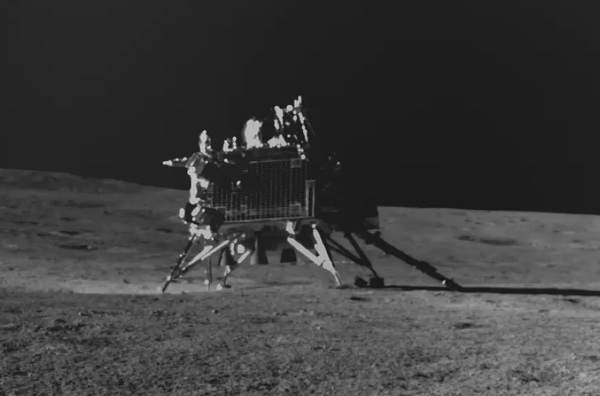 India’s Chandrayaan-3 lander detected sulfur at its landing site, which could provide clues for the origins of water ice at the lunar poles. (credit: ISRO) India’s Chandrayaan-3 lander detected sulfur at its landing site, which could provide clues for the origins of water ice at the lunar poles. (credit: ISRO) |
Searching for the ice hidden on the Moon
by Paul Hayne
Monday, November 27, 2023

Building a space station on the Moon might seem like something out of a science fiction movie, but each new lunar mission is bringing that idea closer to reality. Scientists are homing in on potential lunar ice reservoirs in permanently shadowed regions, or PSRs. These are key to setting up any sort of sustainable lunar infrastructure.
| For planetary scientists like me, measurements from instruments onboard Chandrayaan-3’s Vikram lander and its small, six-wheeled rover Pragyan provide a tantalizing up-close glimpse of the parts of the Moon most likely to contain ice. |
In late August 2023, India’s Chandrayaan-3 lander touched down on the lunar surface in the south polar region, which scientists suspect may harbor ice. This landing marked a significant milestone not only for India but for the scientific community at large.
For planetary scientists like me, measurements from instruments onboard Chandrayaan-3’s Vikram lander and its small, six-wheeled rover Pragyan provide a tantalizing up-close glimpse of the parts of the Moon most likely to contain ice. Earlier observations have shown ice is present in some permanently shadowed regions, but estimates vary widely regarding the amount, form and distribution of these ice deposits.
Polar ice deposits
My team at the Laboratory for Atmospheric and Space Physics has a goal of understanding where water on the Moon came from. Comets or asteroids crashing into the Moon are options, as are volcanic activity and solar wind.
Each of these events leaves behind a distinctive chemical fingerprint, so if we can see those fingerprints, we might be able to trace them to the source of water. For example, sulfur is expected in higher amounts in lunar ice deposits if volcanic activity rather than comets created the ice.
Like water, sulfur is a “volatile” element on the Moon, because on the lunar surface it’s not very stable. It’s easily vaporized and lost to space. Given its temperamental nature, sulfur is expected to accumulate only in the colder parts of the Moon.
While the Vikram lander didn’t land in a permanently shadowed region, it measured the temperature at a high southern latitude of 69.37°S and was able to identify sulfur in soil grains on the lunar surface. The sulfur measurement is intriguing because sulfur may point toward the source of the Moon’s water.
So, scientists can use temperature as a way of finding where volatiles like these may end up. Temperature measurements from Chandrayaan-3 could allow scientists to test models of volatile stability and figure out how recently the sulfur may have accumulated at the landing site.
Tools for discovery
Vikram and Pragyan are the newest in a series of spacecraft that have helped scientists study water on the Moon. NASA’s Lunar Reconnaissance Orbiter launched in 2009 and has spent the past several years observing the Moon from orbit. I’m a co-investigator on LRO, and I use its data to study the distribution, form, and abundance of water on the lunar poles.
| With its sulfur detections, the Vikram lander has now taken the first tentative steps as part of a larger exploration program. |
Both India’s Chandrayaan-1 orbiter and LRO have allowed my colleagues and me to use ultraviolet and near-infrared observations to identify ice in the permanently shadowed regions by measuring the chemical fingerprints of water. We’ve definitively detected water ice in some of these regions inside the coldest shadows at the lunar poles, but we’re still not sure why the ice isn’t more widespread.
On Mercury, by contrast, the permanently shadowed regions are practically overflowing with ice. For several years, scientists have recognized the need to get down on the surface and make more detailed measurements of lunar volatiles. With its sulfur detections, the Vikram lander has now taken the first tentative steps as part of a larger exploration program.
Future lunar missions
NASA has its sights set on the lunar south pole. Leading up to the Artemis 3 mission to deploy astronauts to investigate ice on the surface, the Commercial Lunar Payload Services program will send multiple landers and rovers to search for ice starting late this year.
While uncertainty surrounds the timeline of Artemis launches, the first crewed mission, Artemis 2, is on track for a late 2024 or early 2025 launch, with a looping trajectory passing behind the Moon’s far side and back to Earth.
The Lunar Compact Infrared Imaging System, of which I’m the principal investigator, is an infrared camera that will take temperature measurements and study the surface composition of the Moon. Dubbed L-CIRiS, this camera recently underwent its final review before delivery to NASA, and the completed flight instrument will be prepared to launch on a commercial lander in late 2026.
Prior to L-CIRiS, the VIPER rover mission is planned to launch in late 2024 to the lunar south polar region, where it will carry instruments to search for ice in micro-cold traps. These tiny shadows, some no larger than a penny, are hypothesized to contain a significant amount of water and are more accessible than the larger PSRs.
One long-term goal of L-CIRiS and NASA’s Commercial Lunar Payload Services program is to find a suitable place for a long-term, sustainable lunar station. Astronauts could stay at this station, potentially similar to the one at McMurdo station in Antarctica, but it would need to be somewhat self-sufficient to be economically viable. Water is extremely expensive to ship to the Moon, hence locating the station near ice reservoirs is a must.
During the Artemis 3 mission, NASA astronauts will use the information gathered by the Commercial Lunar Payload Services program and other missions, including Chandrayaan-3, to assess the best locations to collect samples. Chandrayaan-3 and L-CIRiS’s measurements of temperature and composition are like those that will be needed for Artemis to succeed. Cooperation among space agencies young and old is thus becoming a key feature of a long-term, sustainable human presence on the Moon.
This article is republished from The Conversation under a Creative Commons license. Read the original article.
Paul Hayne is an Assistant Professor of Astrophysical and Planetary Sciences at the University of Colorado
The Oldest Black Hole
DISCOVERIES
The Primordial
Astronomers recently discovered that a massive black hole in a galaxy far away is the oldest ever recorded, the Washington Post reported.
The “supermassive” object has roughly the same mass as all the stars in that galaxy – known as UHZ1 – combined, and is believed to be more than 13 billion years old.
To put it into cosmic perspective, the Big Bang happened around 13.7 billion years ago.
For their study, researchers relied on data gathered from two NASA space telescopes: The Chandra X-Ray Observatory and the James Webb Space Telescope.
Data showed that light from UHZ1 was emitted 13.2 billion years ago, while its large size suggests that it began life as a “heavy seed.”
There are two competing theories about the origin of supermassive black holes, known as light seed and heavy seed.
In the light seed theory, stars collapse into stellar mass black holes, gradually growing into supermassive objects. In contrast, the heavy seed theory posits that a large gas cloud, rather than a single star, undergoes gravitational collapse, forming a supermassive black hole without an intermediate phase.
“In this case, we can say with certainty that the black hole came from a heavy seed,” said lead author Akos Bogdan. “It is a pretty big deal.”
While this is only one galaxy, the finding can help scientists better understand how the universe was shaped in its current state, as well as solve the mystery of how these black holes came to be soon after the Big Bang.
Russia’s Spy Satellite Spying On Commercial Satellites
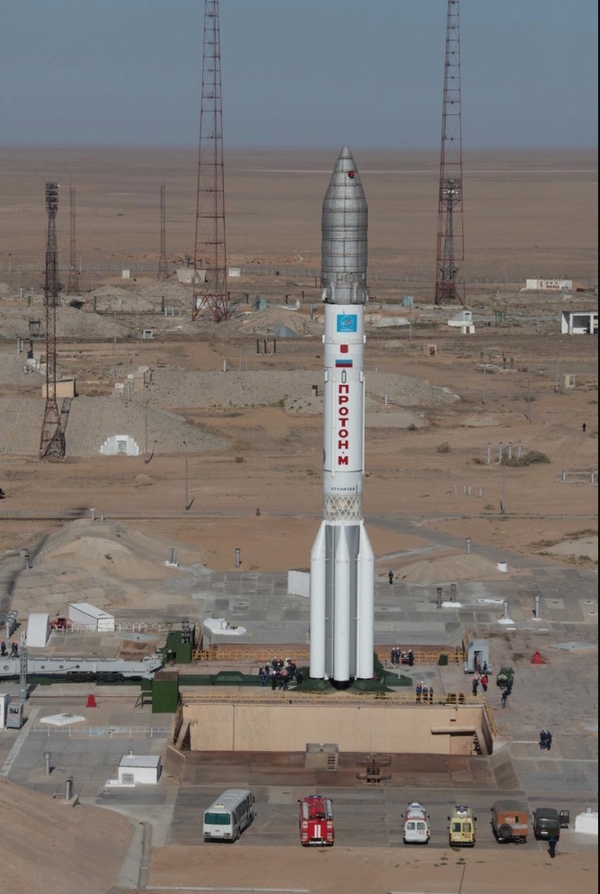 A Proton-M rocket stands poised to launch the Luch/Olimp satellite from Baikonur in September 2014. (credit: Roscosmos) A Proton-M rocket stands poised to launch the Luch/Olimp satellite from Baikonur in September 2014. (credit: Roscosmos) |
Olimp and Yenisei-2: Russia’s secretive eavesdropping satellites (part 1)
by Bart Hendrickx
Monday, November 20, 2023

On March 12 this year, a Proton-M rocket blasted off from the Baikonur Cosmodrome in Kazakhstan, punching its way through a dense layer of fog that only thickened the veil of secrecy surrounding the launch. Although Baikonur is now a civilian launch site that is no longer used for military launches, Roscosmos did not stream the launch live and afterwards reported only that a satellite named Luch-5X had been placed into orbit to test “advanced relay and communication technology.” Its mission is reminiscent of that of another Russian satellite launched in September 2014. Announced simply as Luch, it has spent the past nine years traversing the geostationary belt and regularly parking itself close to commercial communications satellites with the apparent goal of eavesdropping on them.
The travels of Luch/Olimp
The name Luch (“beam”) had originally been applied to a series of geostationary data relay satellites launched in the 1980s and 1990s. Equivalent to NASA’s Tracking and Data Relay Satellites, they had been used among other things to relay data from Russia’s Mir space station. A new generation of such satellites dubbed Luch-5 was introduced early last decade, with three (Luch-5A, 5B, and 5V) going into orbit in 2011, 2012, and 2014. These were known to be the only planned satellites in the series, a clear sign that the satellite launched in September 2014 was flying under a cover name.
| Luch has parked near more than two dozen commercial communications satellites for periods ranging from weeks to months. This is very unusual behavior for a GEO satellite. |
Some clues about the mysterious satellite had been given in March 2014 in an article published by the Russian newspaper Kommersant. Quoting an anonymous “highly-placed source” in the Russian space agency, it identified the satellite as Olimp (the Russian word for Mount Olympus in Greece, often incorrectly transliterated as Olymp) and its manufacturer as Information Satellite Systems (ISS) Reshetnev in Zheleznogorsk (Siberia), Russia’s leading developer of communications and navigation satellites. It would be used for both signals intelligence and communications and had been ordered by the Federal Security Service (FSB), the main descendant of the Soviet-era KGB. According to Kommersant, the satellite was so secret that only one of Roscosmos’ deputy directors was privy to the details of the mission and his further career reportedly hinged on its outcome. Kommersant also reported that the launch had been delayed from 2013 and was then expected to occur in late May.[1] The satellite had earlier appeared under the name Olimp-K in annual reports of several companies that supplied parts for it. The earliest reference to it was in 2008.
After it finally went into orbit on September 27, 2014 (September 28 local time), Luch first drifted to 54.0°E and remained there for three months, seemingly undergoing in-orbit checkouts. It then began moving across the geostationary belt, regularly stopping close to other satellites, something it continues to do nine years after launch. The first satellites it visited were the Russian communications satellites Express-AM22 and Express-AM33, the only Russian satellites it ever approached. Since then it has parked near more than two dozen commercial communications satellites for periods ranging from weeks to months. This is very unusual behavior for a geostationary (GEO) satellite, which usually spends years sitting at the same spot and relocates only sporadically, if ever at all. In addition to that, it has typically parked approximately 0.1 degree (roughly 70 kilometers) away from its target, much closer than the distance that is usually maintained between neighboring GEO satellites.[2]
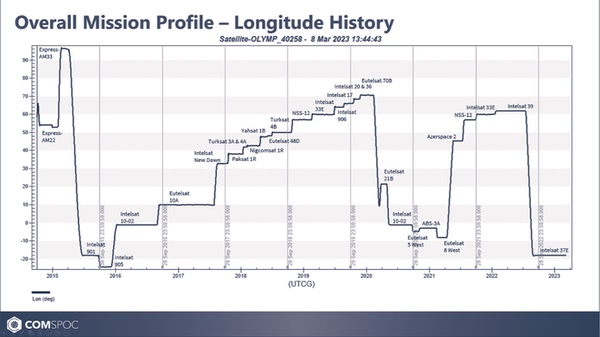 Satellites visited by Luch since its launch in 2014. (larger version) (credit: COMSPOC) Satellites visited by Luch since its launch in 2014. (larger version) (credit: COMSPOC) |
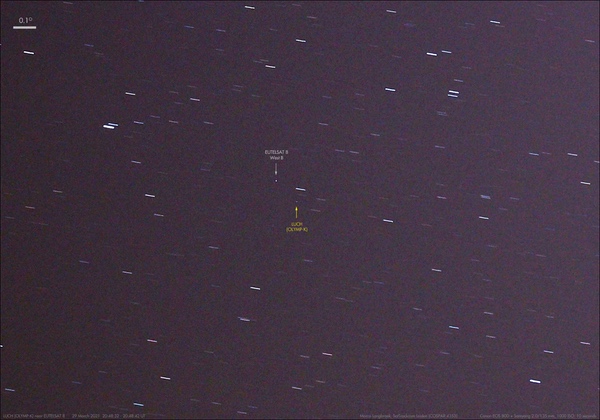 Dutch satellite watcher Marco Langbroek captured this view of Luch/Olimp parked next to Eutelsat 8 West in March 2021. Source Dutch satellite watcher Marco Langbroek captured this view of Luch/Olimp parked next to Eutelsat 8 West in March 2021. Source |
Luch’s mission profile is very similar to that of two classified American satellites named PAN and CLIO, launched in 2009 and 2014. Some details on PAN emerged from secret documents leaked early last decade by Edward Snowden, a former intelligence contractor for the National Security Agency who fled to Russia in 2013. The documents revealed that PAN is part of a project named NEMESIS, the purpose of which was described as “Foreign Satellite (FORNSAT) collection from space”, more specifically “targeting commercial satellite uplinks not normally accessible via conventional means.” As stated in the documents, PAN would “provide the Office of FORNSAT ‘a site in the sky’ when denied a site on the ground for collection”.
FORNSAT is a branch of signals intelligence aimed at intercepting signals from foreign communications satellites. This task can usually be accomplished by eavesdropping stations on the ground if they are within range of an uplink terminal. Other National Security Agency documents in the Snowden archive revealed that it operated dozens such stations all over the globe. NEMESIS was apparently deemed necessary to fill the gaps in ground coverage, moving sufficiently close to satellites of interest to intercept whatever was transmitted to them in all the traditional frequency bands (C, Ku, and Ka). What also transpired from the Snowden files was that the US had used two of its ORION signals intelligence satellites to eavesdrop on the Thuraya-2 satellite, which relays mobile telephone calls from and to countries in the Middle East, Europe, Africa and parts of Asia.[3]
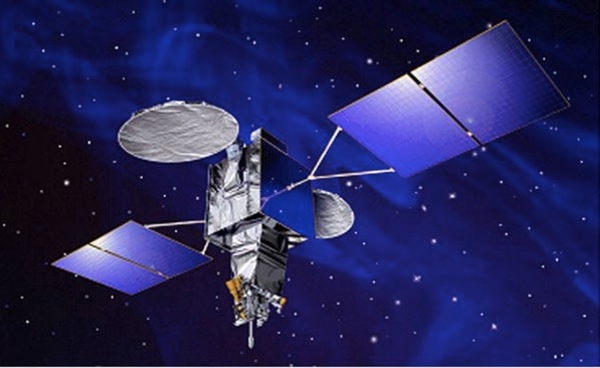 America’s NEMESIS satellite. (Credit: The Intercept) America’s NEMESIS satellite. (Credit: The Intercept) |
Judging from its maneuvers in orbit, there can be little doubt that Luch is on an identical mission. The typical 0.1-degree distance between it and its target is close enough for it to be within the ground uplink beam of the terminal communicating with the neighboring satellite. This is also as close as it got to the two Russian satellites that it visited early in its mission, which most likely served as testbeds to see how close it needed to approach them to intercept the uplink signal.
Currently, Luch is loitering near Intelsat-37e, which it has been shadowing since the summer of last year, longer than any satellite it has visited before. Its recent movements have been closely tracked by Kratos Defense & Security Solutions, a US firm which operates a global network of antennas capable of pinpointing satellite locations to within 100 meters. [4] A graph released by the company shows that Luch is not “parked” in the literal sense of the word since the physics of orbital dynamics dictate a constant motion relative to the other spacecraft. The distances between the two satellites continuously change, with Luch coming as close as 4 kilometers to the Intelsat satellite on October 31, 2022.
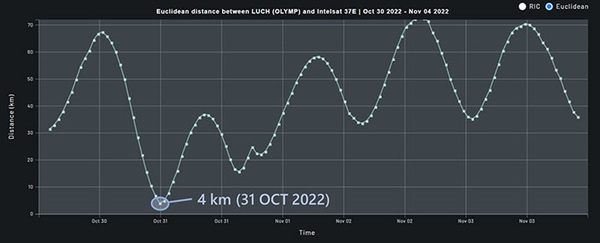 The “orbital dance” between Olimp and Intelsat-37e in October-November 2022. Source The “orbital dance” between Olimp and Intelsat-37e in October-November 2022. Source |
Despite such close approaches, only two satellite operators have openly expressed concern about Luch’s maneuvers. In October 2015, Intelsat criticized Russia for Luch’s “abnormal behavior” after it had maneuvered to within about 10 kilometers of two of its satellites earlier that year. It did underline that no attempts had been made to interfere with the satellites’ services.[5] In September 2018, French Defense Minister Florence Parly accused Russia of having performed an “act of espionage” by flying Luch very close to the French-Italian military communications satellite Athena-Fidus the year before. Closer analysis showed that Luch’s actual target during that particular period had been Paksat-1R, to which it came as close as 1.7 kilometers on November 27, 2017, the closest encounter reported for it so far.[6]
Kratos claimed that by coming so close to Intelsat-37e last October, the Russians disregarded conventions of the International Telecommunications Union (ITU), which sets tolerances for orbital slots in GEO at or above 0.1 degrees (70 kilometers). However, Luch is not unique in this respect. Also passing this threshold on a regular basis are America’s Geostationary Space Situational Awareness Program (GSSAP) satellites. Unlike NEMESIS, GSSAP satellites use optical cameras to take close-up pictures of objects in GEO. According to tracking data collected by the International Scientific Optical Network (ISON), which is managed by the Russian Academy of Sciences, GSSAP satellites have come as close as 10 kilometers to other satellites. Interestingly, the target of one such close encounter on September 14, 2017 was a satellite listed as Luch.
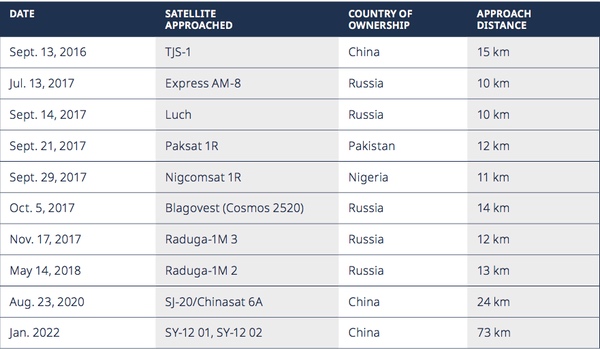 GEO satellites visited by US GSSAP satellites between 2016 and 2022. Source GEO satellites visited by US GSSAP satellites between 2016 and 2022. Source |
Assuming the following two satellites in the list were visited by the same GSSAP satellite, the Luch satellite in question must have been Olimp and not any of the three Luch-5 data relay satellites. Luch was in the same general neighborhood and itself went on to visit Paksat-1R and Nigcomsat-1R in the following weeks and months. From a range of just ten kilometers, GSSAP must have been able to take fairly detailed pictures of Luch, possibly giving analysts a fairly good idea of its capabilities.
Olimp design features
While GSSAP may have furnished the US intelligence community with sharp closeup images of Luch/Olimp, there are no pictures or drawings of the satellite in the public domain. A search of Russian online sources turns up only a handful of design details. Obviously, the extensive maneuvers made by Olimp in the past nine years can only have been performed with electric thrusters. Two press reports in 2014 and 2017 (which don’t mention the satellite by name) make it possible to identify those thrusters as KM-60, a new type of Hall-effect thruster built for the satellite by the Keldysh Research Center in Moscow.[7] This is confirmed in an article published by the Keldysh Center which links the thruster to an unnamed ISS Reshetnev satellite launched in 2014.[8]
| From a range of just ten kilometers, GSSAP must have been able to take fairly detailed pictures of Luch, possibly giving analysts a fairly good idea of its capabilities. |
The KM-60 is a 930-watt thruster with a thrust of 42 millinewtons and an average specific impulse (over its entire lifetime) of 1,860 seconds. A unique feature is said to be its discharge voltage of 500 volts, which makes it up to 25% more fuel-efficient than similar thrusters. It is designed to operate for more than 4,000 hours and to be ignited up to 8,250 times. The 3.1-kilogram thruster is integrated with a power processing unit, a flow control unit, a feeding unit, and a tank (MVSK50) containing 71 kilograms of xenon. The engine underwent a 9.5-year development period that saw it work for a total of 4,120 hours during 8,357 burns. It is not known exactly how many of the thrusters and xenon tanks are on board Olimp.
 The KM-60 Hall thruster and its flow control unit. Source The KM-60 Hall thruster and its flow control unit. Source |
The KM-60 thrusters were ordered by ISS Reshetnev for a satellite platform known as Express-1000. This comes in several versions with masses ranging from about 1,200 to 2,300 kilograms and has a design lifetime of 15 years. According to a brochure published by the Keldysh Center in 2011, the KM-60 was intended for satellites with a mass of “up to 1,500 kg” and when the thruster was put on display during an exhibition in 2022, it was reported to be compatible with “lightweight geostationary satellites.”[9]
In a 2017 presentation of ISS Reshetnev, an unnamed satellite that is almost certainly Olimp was identified as being of the Express-1000H type, which has a maximum mass of around two tons (the values given by ISS Reshetnev differ).[10] Other satellites using this particular bus do have SPD-100V electric thrusters of the OKB Fakel design bureau. Olimp, the only satellite known to have the KM-60 thrusters, may therefore employ a unique version of the bus that is not seen in technical literature. Possibly, it has been adapted to enable the satellite to carry out more maneuvers than traditional communications satellites, for instance by reducing the mass of the payload or increasing the propellant mass. When equipped with the SPD-100V thrusters, the Express-1000H platform can carry a maximum of four MVSK50 xenon tanks, which translates into a total xenon mass of around 300 kilograms.
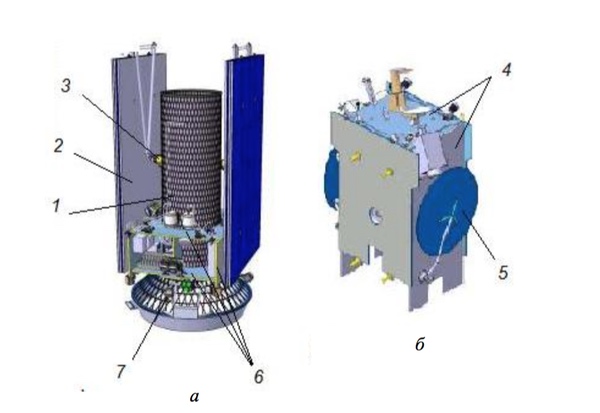 ISS Reshetnev’s Express-1000H satellite bus. Source ISS Reshetnev’s Express-1000H satellite bus. Source |
An unknown Express-1000 type satellite is seen in a 2016 presentation of ISS Reshetnev. Three satellites shown here are said to belong to the orbital constellation of “RTRR” and “RP” satellites. The first abbreviation possibly stands for “radio-technical and radio reconnaissance” (the Russian terms for electronic and communications intelligence) and the second for “radio interception” (radioperekhvat in Russian), which is exactly what Olimp does. The satellite in the upper part of the slide can be identified as Repei, a new generation of signals intelligence satellites designed to pick up ground-based radio transmissions. The one on the left is an Express-1000 platform with two parabolic antennas. It is not seen in other publications and could be Olimp.[11]
 The satellite in the lower left is an unidentified Express-1000 type satellite that may be Olimp. (Credit: ISS Reshetnev) The satellite in the lower left is an unidentified Express-1000 type satellite that may be Olimp. (Credit: ISS Reshetnev) |
If Olimp weighs less than two tons, it was a relatively light payload for the Proton-M/Briz-M combination, which is capable of placing up to 3.5 tons into GEO. In fact, all the other Express-1000H type satellites have been launched along with other payloads. The secrecy surrounding Olimp may well be one of the reasons why it did not share a ride with a “regular” communications satellite. A special partition was reportedly erected around Olimp during its pre-launch processing at Baikonur to prevent unauthorized personnel (including foreign engineers working on other Proton payloads) from catching a glimpse of it.[12]
Also on board the satellite are so-called thermal catalytic thrusters (K50-10.5) of OKB Fakel. [13] These are monopropellant hydrazine thrusters commonly flown on ISS Reshetnev communications satellites in combination with electric thrusters. The electric thrusters are used for orbit corrections (both changes in altitude and longitude) and the chemical thrusters for attitude control.
Another novelty introduced by Luch/Olimp was a new type of lithium-ion battery (LIGP-50) developed by PAO Saturn in Krasnodar.[14] Also flown for the first time was a pair of fiber optic gyroscopes for the satellite’s inertial navigation system. Called VOBIS-1 and 2, they were developed by NPK Optolink in Zelenograd near Moscow, which is the hub of Russia’s microelectronics industry (sometimes called “Russia’s Silicon Valley”).[15]
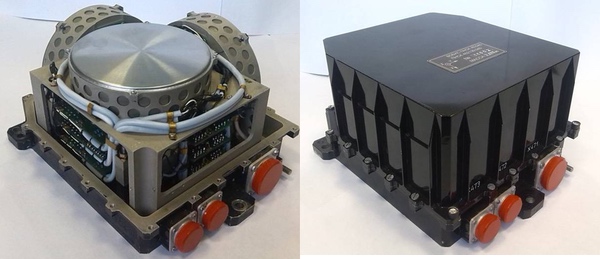 Olimp’s VOBIS fiber optics gyroscope. Source Olimp’s VOBIS fiber optics gyroscope. Source |
Other known subcontractors are NPP Kvant for gallium arsenide solar panels and NPP Geofizika-Kosmos for optical sensors needed by the satellite’s attitude control system. [16]
Very little is known about the payload(s) of Olimp. As can be determined from an online procurement document published in 2012, the company in charge of the payload, or at least part of it, is the Radio Research and Development Institute (NII Radio or NIIR) in Moscow.[17] NII Radio is an organization that builds both ground-based satellite dish antennas and payloads for communications satellites. It is also the prime contractor for a project named Sledopyt (“pathfinder”), a network of four ground-based signals intelligence sites that are intended to pick up signals from foreign satellites flying over Russia.[18] In that respect, its assignment to a project for in situ foreign satellite intelligence in GEO makes sense.
Little else can be learned from the 2012 document except that it appears to be related to a payload operating in the L-band of the radio spectrum. Another payload considered for Olimp was a 2.2-mеter Ku-band antenna made of carbon fiber composites and aluminum honeycombs and weighing no more than 14 kilograms. This was mentioned in 2016 in a presentation of the Baltic State Technical University in St.-Petersburg, where it reportedly finished preliminary qualification tests in 2011 [19]. The development period is given as 2008–2012. The only other publication where the antenna is seen is a PhD dissertation published in 2014, some results of which were applied in the Olimp project.[20] Whether the antenna is actually on board Olimp is not known.
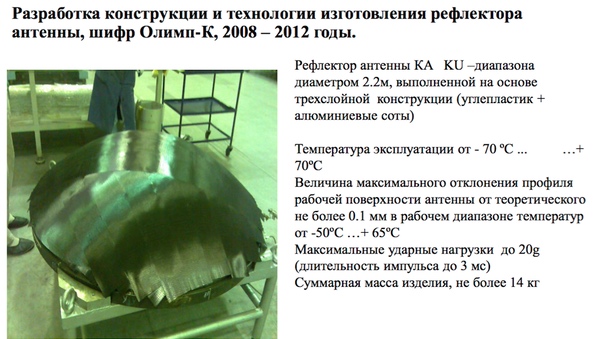 Ku-band antenna for Olimp developed between 2008 and 2012. Source Ku-band antenna for Olimp developed between 2008 and 2012. Source |
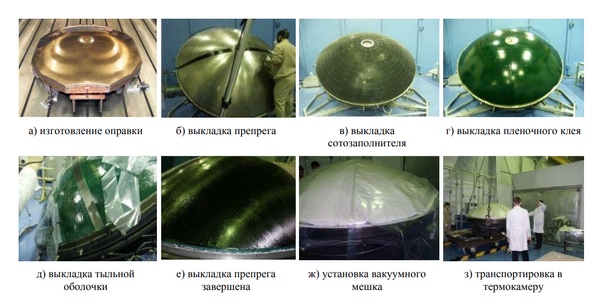 The same Ku-band antenna during various stages of production. Source The same Ku-band antenna during various stages of production. Source |
| Whatever the eavesdropping payload of Olimp exactly is, it probably doesn’t look out of the ordinary. |
ISS Reshetnev’s former general director Nikolai Testoyedov wrote in a 2016 report that a “Luch type satellite” launched in 2014 had made it possible to perform flight tests of “a large-size 12 m unfurlable antenna for personal communications.” He could not have been referring to the Luch-5V data relay satellite launched in April 2014, because that only has much smaller antennas, leaving Luch/Olimp as the only other candidate. Still, that information was almost certainly inaccurate. The relatively light Express-1000H platform is most likely incompatible with such a large antenna. Ð 12-meter antenna for personal mobile communications had been supposed to fly as an additional payload on the Luch-4 data relay satellite, which was to use the heavier Express-2000 platform. After the cancelation of Luch-4 early last decade, Roscosmos came up with plans for a dedicated experimental mobile communications satellite called Yenisei-A1, which would carry a somewhat larger antenna and employ the even heavier Express-4000 platform. In a 2021 article, Testoyedov claimed that a 12-m antenna would fly in 2023, but it looks like this is intended for a military communications satellite called Sfera.[21] There is no evidence that an antenna of that size has already flown on a Russian satellite.
Whatever the eavesdropping payload of Olimp exactly is, it probably doesn’t look out of the ordinary. Even though Olimp is essentially a signals intelligence satellite, it does not need to carry the huge antennas that traditional SIGINT satellites have to pick up faint transmissions from the ground. All it has to do is tune its equipment to match the channels in use, record the signals for as long as is needed and then relay them to the ground like an ordinary communications satellite. Similarly, America’s NEMESIS satellites are built on the basis of a standard communications satellite platform (Lockheed’s A2100 bus) and have relatively small antennas.
It has been speculated by some that Olimp may also carry one or more cameras to take close-up images of the satellites that it visits. While that possibility cannot be excluded, there is no evidence for the presence of imaging systems aboard the satellite. Since all the satellites visited by Olimp are commercial communications satellites, any pictures taken by Olimp would probably add little to what is already publicly known about them.
With a 15-year design lifetime, Luch/Olimp should have at least six years ahead of it. However, the fact that it has not changed position since the summer of 2022 is a possible indication that it doesn’t have much propellant left for further maneuvers. Another reason may be that its mission is being taken over by a new satellite launched earlier this year.
The launch of Luch-5X
The first sign that another mysterious Luch satellite was being prepared for launch came in February 2020, when the general director of the Khrunichev Center (the manufacturer of the Proton-M rocket) told a visiting delegation that the launch of what he called a “Luch-5 satellite in the interests of ISS Reshetnev” was scheduled for launch in 2021.[22] By the time the satellite’s Proton-M rocket was shipped to Baikonur in March 2021, the launch had slipped to 2022. In its press release on the shipment, Khrunichev initially identified the payload as “Luch-5X” only to delete that information shortly afterwards. Since the next Luch-5 data relay satellite (a modified version called Luch-5VM) was not due for launch until the mid-2020s, it was obvious to observers that Luch-5X was a cover name for a possible successor to Luch/Olimp.
After several more launch delays, the Proton-M finally lifted off late on March 12, 2023 (March 13 local time). In a very terse launch announcement, Roscosmos reported that Luch-5X had been inserted into the planned orbit and would test “advanced relay and communication technology.”[23] The TASS news agency misleadingly called it another Luch data relay satellite “to exchange data between the ISS Russian segment and mission control.” When Russia officially registered the launch with the United Nations several weeks later, it described the satellite’s function as “relay of information.” The Roscosmos press release was accompanied by a picture purportedly showing the Proton’s nighttime launch, but this later turned out to be a file photo of an earlier launch. As can be seen in a webcast of the launch that later appeared on YouTube, the fog at Baikonur was so thick that even cameras close to the pad could barely see the rocket.
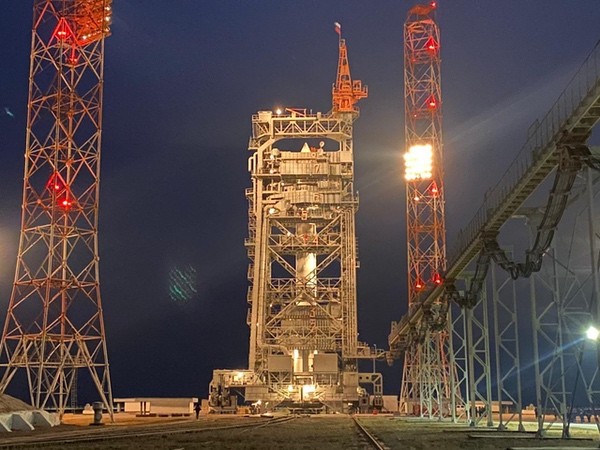 The Proton-M rocket with the Luch-5X satellite undergoing final launch preparations at Baikonur. Source The Proton-M rocket with the Luch-5X satellite undergoing final launch preparations at Baikonur. Source |
After launch, Luch-5X slowly drifted to 78.7°E and then began moving backwards, finally coming to a stop at 58.0°E. This is where it appears to have undergone its initial orbital checkout, maintaining a normal distance of 0.5° with neighboring satellites. After about a month, Luch-5X resumed its westward trek. Unlike Luch/Olimp, it did not stop by any Russian satellites first and on May 22 it settled at 8.9°E, right next to two satellites, Viasat’s KA-SAT (formerly known as Eutelsat KA-SAT 9A) and Eutelsat-9B. This eliminated any remaining doubt that Luch-5X is on a mission similar to that of Olimp. The two satellites share a spot at 9.0°E, which is not uncommon for satellites owned by the same operator (KA-SAT was already at that location before it was purchased from Eutelsat by Viasat in 2020). Based on orbit analysis, only KA-SAT was a target for Luch-5X.
Luch-5X parted company with the two satellites on September 27 and one week later arrived at 3.2°E, right next to Eutelsat-3B at 3.1°E. All this undoubtedly is just the beginning of a long voyage through the geostationary belt that will see Luch-5X visit multiple satellites over the coming years. It is being closely monitored in the West, among others by two American startups (Slingshot Aerospace and DigitalArsenal) that are using advanced software and artificial intelligence to track the satellite’s movements and predict future targets. [24]
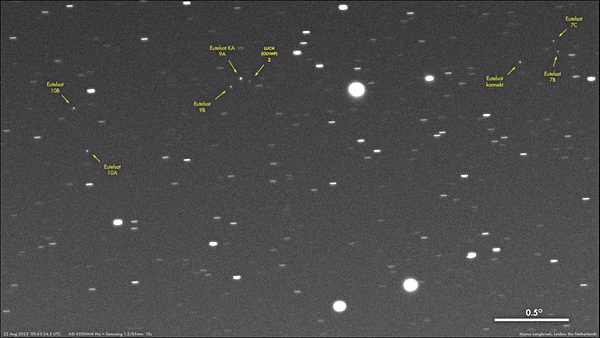 Marco Langbroek photographed Luch-5X parked next to KA-SAT (referred to here as Eutelsat KA 9A) and Eutelsat 9B on August 22. Source Marco Langbroek photographed Luch-5X parked next to KA-SAT (referred to here as Eutelsat KA 9A) and Eutelsat 9B on August 22. Source |
Yenisei-2
There are only two traces of a follow-up Olimp satellite in online procurement documentation. In early 2014, NII Radio, the company involved in building the payload for the first Olimp, awarded a contract for the development of so-called “pattern forming equipment” (DOA) for the project under the name Olimp-1 DOA. This was several months before the launch of the first Olimp satellite in September 2014, but the work was to take place in several stages and was not expected to be completed until 2019, meaning it was related to a second satellite. [25]
In late 2017, ISS Reshetnev ordered parts for a high-pressure xenon tank (KBVD) to be flown on an Olimp satellite. This is one sign that the second satellite is not a carbon copy of its predecessor. Whereas KBVD is a tank built in-house by ISS Reshetnev, Luch/Olimp carried one or more xenon tanks supplied by another company (the MVSK50 tank of NIIMash). The KBVD tanks come in several versions and are designed to fly on all of ISS Reshetnev’s Express platforms (Express-1000, 2000, and 4000), making it impossible to say whether the second satellite uses a different bus than the first one.
The first version (with a capacity of 350 kilograms versus the 71 kilograms offered by the MVSK50 tank) was flown on the Express-AM6 communications satellite, an Express-2000 type satellite launched in October 2014. Slightly improved versions were installed on two Express-1000H type satellites orbited in July 2020 (Express-80 and 103) and a much-upgraded model with a capacity of 500 kilograms or more was supposed to go up on the so far unflown Express-4000 platform. The KBVD tanks flown to date have been used to feed SPD-100V electric thrusters of OKB Fakel. Since the components that were ordered for Olimp’s KBVD tank in 2017 were to be delivered by OKB Fakel, the satellite may very well have those thrusters rather than the Keldysh Center’s KM-60 engines that are on board Luch/Olimp.[26]
The KBVD tank was designed mainly to give satellites enough xenon reserves in case they are not directly inserted into GEO by the Proton rocket and need to maneuver to their final orbit by themselves. However, unlike Express-AM6, 80, and 103, Luch-5X followed a direct-insertion launch profile. If it indeed carries the KBVD tank, it can use its full capacity for the extensive maneuvers that it is expected to make in GEO.
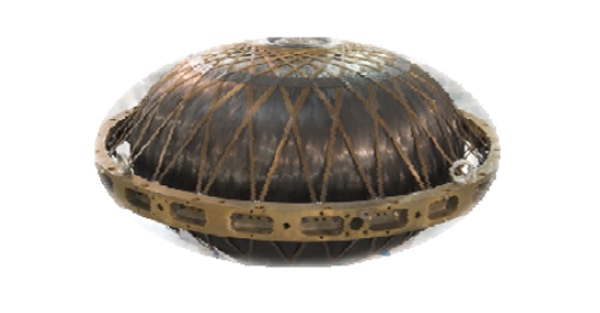 ISS Reshetnev’s KBVD high-pressure xenon tank. Its dimensions are given as 115.5 by 70 cm. Source ISS Reshetnev’s KBVD high-pressure xenon tank. Its dimensions are given as 115.5 by 70 cm. Source |
Confusingly, there is also evidence for an ISS Reshetnev satellite that is clearly closely related to Olimp, but goes under a different name, namely Yenisei-2. (Yenisei is a river in Siberia.) It has turned up only in a handful of online procurement and court documents as well as in two short biographies of ISS Reshetnev specialists. [27] The dearth of information on the satellite is a sure sign that ISS Reshetnev wants to keep it out of the public eye. There is most likely no relation with the experimental mobile communications satellite Yenisei-A1, which has probably been canceled.
| The available information suggests that Yenisei-2 is a satellite using some of the same payload components as Olimp, but is not identical to it. |
The most valuable information on Yenisei-2 can be gleaned from a series of procurement documents placed online in 2014. From these it can be learned that Yenisei-2 is a GEO satellite with a design lifetime of 15 years. Despite the secretive nature of the satellite, there are no indications in the documents that Yenisei-2 is a military project. They do not reveal when and by which organization ISS Reshetnev was ordered to build the satellite. What is disclosed is that on February 1, 2014, ISS Reshetnev awarded two separate contracts for the satellite’s payload to NII Radio. NII Radio in turn signed several contracts for the delivery of payload components with the Izhevsk Radio Factory (IRZ). For the manufacturing and testing of some of these, IRZ was to make use of “stocks, technical documentation and equipment produced in the framework of the Olimp project.”[28]
Most of these components are subsystems that reveal little about the exact nature of the payload. Among the documents are contracts for three receivers, one transmitter, and four frequency converters, all of which are either identical to or derived from those flown on Olimp. One instrument mentioned in the documentation is called MAGD-O and intended to receive and process L-band signals between 1.5 and 2.5 gigahertz. Weighing around 14 kilograms, it consists of several so-called “group demodulation units”, each of which can receive two L-band signals and generate a digital output stream at a constant speed of 250 megabits per second (Mbps). Although Luch/Olimp also appears to have an L-band payload, MAGD-O is not linked in the documents to Olimp, which means it may be unique to Yenisei-2.
One of NII Radio’s subcontractors (the Special Design Bureau of the Kotelnikov Institute of Radio-Engineering and Electronics (SKB IRE)) provided an L-band switching system, presumably needed to route L-band signals from the satellite’s receiver to its transmitter. Another component not linked to Olimp in the documents is designated MPS and designed for “the receipt of information streams, their multiplexing and the formation of two streams with a speed of 320 Mbps”. In addition to that, it has to “mask the technical characteristics of the streams” by scrambling them. [29] Possible uses of these payloads will be discussed in part 2 of this article.
There are at least two indications that Yenisei-2 may have multiple payloads. First, NII Radio received two separate contracts from ISS Reshetnev for the project in February 2014. Second, one abbreviation seen in the documents is “BSK-2”, which stands for “On-board special complex 2”. BSK is a term applied to a set of instruments that together constitute a payload, so BSK-2 suggests there are at least two.
Virtually nothing can be deduced from the documentation about Yenisei’s 2 bus, except that it is equipped with electric thrusters. The 15-year design lifetime given for Yenisei-2 is typical of all ISS Reshetnev satellites being manufactured now, not only the Express-1000 bus, but also the heavier Express-2000 and 4000 platforms.
In short, the available information suggests that Yenisei-2 is a satellite using some of the same payload components as Olimp, but is not identical to it. The two also seem to have different internal project numbers at ISS Reshetnev. Some of the Yenisei-2 documents mention Project 763, wheras the serial number of Luch/Olimp (762V N°79448211) indicates it is part of Project 762 [30].
Evidence that the satellite launched as Luch-5X belongs to Project 763 comes from a study that assessed the environmental impact of the Proton launch that placed the satellite into orbit. The study was carried out by a team at Moscow State University (MGU) under the contract number 763-24/20/Luch/MGU.[31] It is quite common for project numbers to appear in such contract names. The same number is also seen in a contract for structural tests of the KBVD high-pressure xenon tank conducted for ISS Reshetnev by the Russian Academy of Sciences’ Institute of Computing Technology (IVT SO RAN) in 2019. [32] This is most likely the very same tank that was linked to an Olimp satellite in the procurement documentation released by ISS Reshetnev in 2017.
The conclusion is that Luch-5X is a sister satellite of Luch/Olimp, but has undergone enough changes to both its bus and payload to be given a new internal project number at ISS Reshetnev (763) as well as a new name (Yenisei-2). The names Olimp-2 and Olimp-K-2 seen in some online publications emanate only from Western sources. The earliest known contracts for the satellite were signed in February 2014, meaning that its development got underway well before the launch of Luch/Olimp in September 2014.
The launch of Luch-5X seems to have been delayed by at least two years. One reason for that may have been the need to incorporate changes into the spacecraft on the basis of the Luch/Olimp mission. Another could well be problems with the supply of foreign-built electronic components due to sanctions imposed on Russia by Western countries. Although Russia does not readily admit that the sanctions are having a major impact on the space industry, there are plenty of signs that this is indeed the case. Occasionally, the frustration over the delays resulting from the sanctions spills out into the open. For instance, during parliamentary hearings in June 2021, the then-chief of the Russian space agency, Dmitriy Rogozin, complained that nearly fully assembled satellites were grounded due to a lack of electronic components. “We have plenty of rockets, but nothing to place into orbit”, he said.[33]
Still, sanctions have clearly not stopped the Russians from ordering Western electronics for the eavesdropping satellites. Some of the Yenisei-2 documents placed online in 2014 stated that foreign-built electronic parts for the satellite’s payload could be selected from the “NASA Core Suppliers List,” a list of manufacturers that NASA considers preferred suppliers of microcircuits, transistors and diodes. Another online document published in 2020 gives a list of Western-built microcircuits purchased for a component of Yenisei-2’s payload named M-761A.
Western-built electronic parts purchased for Yenisei-2’s payload. Source
| Supplier | Component name |
|---|---|
| Firadec (France) | CTC 21 |
| 3D-Plus (France) | 3DEE1M08CS1193MS |
| STM (France) | RHFL4913ESY2505V, RHFL4913ESY3305V |
| Temex (France) | TE100EB21111M059 |
| MicroSpire (France) | CMC15 52K 2WR, SESI9.1 M10 2WR |
| Intersil (US) | IS9-705RH-Q, HS9-139RH-Q, HS9-26CLV31RH-Q, HS9-26CLV32RH-Q |
| Xilinx (US) | XQR17V16CC44V, XQVR600-4CB228V |
| International Rectifier (US) | ARE10005S/CKC, ARE10005S/EM |
| Glenair (US) | M83513/22-A 03NW-429C, M83513/22-B 03NW-429C, M83513/25-A 03NW-429C, M83513/25-B 03NW-429C |
| Spectrum Control (US) | 52-970-205-FA3, 52-970-205-HA1, 52-970-208-FB0, 52-970-216-FC1, 52-970-218-FC0, 52-970-208-FB1 |
| Harwin (US) | 221T22F22H, 221T04F22H, D308 6-99 |
| C&K (US) | 340100101BDEM9PNMB1A9N |
| TYCO Electronics | 5-1437514-9, 6-1437514-8 |
Such parts are not purchased directly by ISS Reshetnev or its main subcontractors, but by Russian intermediaries that act as go-betweens between the Russian space industry and foreign suppliers. For instance, a company named NPTs Shtandart acquired foreign-built electronic parts for Yenisei-2’s payload and then delivered them to another company (NPTs Eltest) for acceptance testing before they were supplied to NII Radio, the payload manufacturer. Delays in the delivery of such electronic parts were the subject of two court cases between these companies, but they seem to have resulted from bureaucratic issues rather than import restrictions.[34]
The target satellites
Like America’s NEMESIS satellites, Luch and Luch-5X have eavesdropped only on commercial communications satellites. The bulk of these belong to Intelsat and Eutelsat. The others are owned by smaller private operators (Yahsat, SES, ABS and Viasat) and by national operators (Turkey, Pakistan, Azerbaijan, Pakistan and Nigeria). Three of the satellites (Intelsat-10-02, Intelsat-33e, and NSS-12) have received two visits. The vast majority of the satellites operate solely in the C- and Ku-bands and only some also have high-throughput Ka-band payloads. Coincidentally or not, four out of five satellites visited since early 2022 have Ka-band capacity. These are Intelsat-33e and -37e, both targets of Luch, and Viasat KA-SAT and Eutelsat-3B, the first two satellites visited by Luch-5X.
| Luch changed its mission profile in the months leading up to the Russian invasion of Ukraine in early 2022. Since then it has visited only Intelsat satellites, spending more time in their vicinity than generally seen before. |
Exactly what kind of information Russia (and the US, for that matter) is trying to extract from the intercepted signals is a matter of speculation. One can assume that the main interest lies in data and voice traffic, possibly with the aim of carrying out economic and industrial espionage (economic espionage is one of the goals of US SIGINT satellites explicitly mentioned in documents leaked by Edward Snowden.) Moreover, many of these satellites provide services not only to private, but also government and military customers. For instance, the US and European militaries lease significant bandwidth on Intelsat and Eutelsat satellites, using them for a variety of traffic, from unmanned aircraft video feeds to mobile ground communications.
Some observers have drawn attention to the fact that Luch changed its mission profile in the months leading up to the Russian invasion of Ukraine in early 2022. Since then it has visited only Intelsat satellites, spending more time in their vicinity than generally seen before. The Intelsats in question (33e, 39, and 37e) transmit Ku- and C-band frequencies over Ukraine. These are often used for secure military communications.[35] Intelsat-33e and 37e, both belonging to the Epic series, provide both government and military users with high-powered Ku-band spot beams that enable bandwidth applications such as high-definition full-motion video using compact antennas for ground and maritime users. It is unclear though if they support any military operations in Ukraine.
It is also worth noting that Viasat’s KA-SAT fixed broadband network fell victim to a major cyberattack just hours before the beginning of the war on February 24, 2022. While the attack was not aimed against the satellite itself, it rendered inoperable thousands of Viasat KA-SAT satellite broadband modems in Ukraine, including those used by military and government agencies. It also impacted tens of thousands of Viasat customers across Europe. KA-SAT was a target for Luch-5X between May and September 2023, well after the attack took place. Although the satellite is unlikely to have any electronic warfare capabilities, it could potentially have gathered data on KA-SAT that might facilitate further cyberattacks. A report in Aviation Week last May claimed that attacks against the Viasat network were still ongoing at the time. [36]
References
- Article published in Kommersant, March 24, 2014. The journalist who wrote the article (Ivan Sarfonov) is now serving a 22-year prison sentence after having been arrested by that very same FSB in 2020 on (unrelated) charges of state treason.
- Olimp’s orbital behavior is discussed in detail in a 30-minute video released by ComSpOC in 2019.
- М. Langbroek, A NEMESIS in the sky, The Space Review, October 31, 2016.
- M. Clonts, Espionage in orbit : satellite or spy?, Kratos, April 17, 2023.
- M. Gruss, Russian satellite maneuvers, silence worry Intelsat, SpaceNews, October 9, 2015.
- T. Roberts, Luch (Olymp) / Athena-Fidus, Satellite Dashboard, December 14, 2020.
- Press release by the Moscow Institute of Physics and Technology, October 23, 2014 ; Report by the TASS news agency, September 25, 2017.
- Article published by the Keldysh Research Center in 2020. A description of the thruster in English can be found here: V. Vorontsov et al, Development of KM-60 based orbit control propulsion subsystem for geostationary satellite , Procedia Engineering, 2017.
- Russian press article, August 15, 2022. This has a picture of an exhibition model of the KM-60 with accompanying data. It is confirmed that the thruster has been used on an Express-1000 type satellite since 2014.
- Presentation on ISS Reshetnev satellites published in 2017 (see p. 12). The “H” in Express-1000H appears to be a Latin “H” rather than a Cyrillic “H” (which is rendered as “N”). The platform is also spelled Express-1000H in English-language literature of ISS Reshetnev intended for foreign customers. The “H” presumably stands for “heavy” (this being a heavier version of the Express-1000 platform).
- The 2016 presentation of ISS Reshetnev is no longer online. The satellite in the lower right is identified by another source as Gonets-M1, a low-orbiting communications satellite. In the latest proposals, it looks significantly different. It is not clear why it is shown here together with Repei and what may well be Olimp.
- A. Zak, Proton successfully returns to flight delivering a secret Olymp satellite, RussianSpaceWeb.com (last updated 2015).
- This is the thermal catalytic thruster given for Luch on an old version of OKB Fakel’s website. The satellite’s Hall thruster was wrongly identified as the KM-5.
- Press release by ISS Reshetnev in September 2019, posted on a Russian space forum ; Presentation by PAO Saturn in 2019 (no longer available online).
- Y. Korkishko et al, Fiber optic gyro for space applications. Results of R&D and flight tests, paper presented during the 2016 IEEE International Symposium on Inertial Sensors and Systems ; Paper presented by ISS Reshetnev and NPK Optolink during a 2017 space conference in Tarusa (p. 174-186).
- Annual reports of NPP Kvant (2010) and NPP Geofizika-Kosmos (2009, 2011, 2013).
- Procurement documentation published in November 2012.
- B. Hendrickx, Russia gears up for electronic warfare in space (part 2), The Space Review, November 2, 2020.
- Presentation by the Baltic State Technical University, 2016.
- PhD dissertation published in 2014.
- Article by N. Testoyedov published in 2021 (p. 1080–1081).
- Report by the TASS news agency, February 12, 2020.
- The “X” in Luch-5X (spelled Луч-5Х in Russian) is a Latin “X” and not a Cyrillic “X” (which is pronounced differently and transliterated as “Kh”). It is pronounced as a Latin “X” in the Russian webcast of the launch (placed online after the launch) and the satellite was officially registered with the United Nations as Luch-5X in several languages.
- Luch-5X blog of Slingshot Aerospace ; Computer-simulated videos of Luch-5X’s movements near Eutelsat KA-SAT 9A and Eutelsat-3B, posted by DigitalArsenal CEO TJ Koury.
- Procurement documentation published in May 2014.
- Procurement documentation for Olimp’s KBVD tank published in October 2017. Ехаctly the same components were ordered for the KBVD tanks of Express-80 and 103, which both have OKB Fakel’s SPD-100V thrusters. See procurement documentation published in September 2017.
- Biographies of Yuri Oberemok and Andrei Leonenkov.
- Yenisei-2 first appeared in procurement documentation published in May 2014. Other examples of procurement documentation related to Yenisei-2 can be found here.
- Procurement documentation published in late 2014 for MAGD-O, the L-band switching system and the MPS system.
- The serial number of Luch/Olimp is given on the Kosmonavtika website.
- The contract number for MGU’s environmental impact study is seen here.
- The contract number for IVT SO RAN’s structural tests is seen here.
- Report by the TASS news agency, June 7, 2021.
- Court documentation published in 2021 (1, 2).
- Space Threat Assessment 2023, Center for Strategic & International Studies, p. 19-20.
- Viasat KA-SAT satellite in Europe still under attack in 2023, Aviation Week, May 16, 2023 (paywalled article).
Bart Hendrickx is a longtime observer of the Russian space program.
Why You Should Care About Life Beyond Earth
 Space settlements could ensure a future for life beyond Earth in the event of natural or human-made catastrophes. (credit: Blue Origin) Space settlements could ensure a future for life beyond Earth in the event of natural or human-made catastrophes. (credit: Blue Origin) |
Why you should care about life beyond Earth
by Tyler Bender
Monday, November 20, 2023

Life on Earth has faced five mass extinctions over the past 500 million years. Ensuring the long-term survival of life as we know it will require humanity learning how to migrate the myriad species of Earth off their home planet, because, as its long history shows, this planet can sometimes be a very dangerous place for life to be. If we are truly concerned for the well-being of generations long to come, then we owe to them our commitment to establishing permanent, sustainable habitats in outer space. The longer we choose to not act, the longer we test our fate.
| The longer we choose to not act, the longer we test our fate. |
Mass extinctions have had various natural causes. Some, such as the Permian extinction of 250 million years ago, resulted from internal forces. This extinction, also known as the “Great Dying”, was most likely caused by a series of massive volcanic eruptions that wiped out 90 percent of all species.[1] Spilling over four million cubic kilometers of lava across what is now Siberia, these eruptions wreaked havoc on a global scale, ejecting vast amounts of sulfur and carbon dioxide into the atmosphere, poisoning both the air and the oceans.[2]
External forces have caused mass extinctions as well. Most infamously, the end-Cretaceous extinction came about 66 million years ago when asteroid ten kilometers in diameter impacted Earth near what is now Mexico’s Yucatan Peninsula.[3] Striking the planet with the force of 100 million megatons of TNT[4] (equivalent to two million detonations of the Tsar Bomba, the largest nuclear weapon ever tested)[5] , the asteroid generated massive earthquakes and tsunamis in the region of the impact and led to devastating consequences for life across the globe: ejecta from the impact ignited massive wildfires as far away as Australia, heat-induced chemical reactions caused acid rain to fall for months, and dust and aerosols shut down photosynthesis in plants by blocking the light from the Sun. This effect on plant life broke down the food chain and spelled the end not only for most herbivores, but also for the carnivores that hunted them.[6] Ultimately, the asteroid impact would eliminate 75 percent of terrestrial and marine species.[7]
Luckily, we have taken steps to reduce the risk of an asteroid impact sending us the way of the dinosaur. According to data from the Johns Hopkins University Applied Physics Laboratory, of the 1,000 near-Earth objects that are large enough to have a global impact effect, only four have a mass large enough to cause mass extinctions, and neither of these is currently on track to pose an impact threat.[8] Additionally, efforts like NASA’s recently successful DART mission highlight our ability to potentially alter the path of near-Earth objects that may pose a threat in the future (assuming that we recognize those threats in time to react and they are not so large that deflection is a futile effort).
Asteroids, however, are not the only extraterrestrial threat to life as we know it. The Ordovician-Silurian extinction was likely caused by an abrupt decline in global temperatures and mass glaciation about 440 million years ago. Experts are still searching for evidence to determine the trigger for this deadly era of global cooling, but some theorize that it was caused by a massive gamma-ray burst from a relatively nearby supernova. Such an event could have depleted Earth’s ozone layer by as much as 40 percent, allowing more ultraviolet radiation from the sun to pass through the atmosphere, poisoning all organic matter in the direct path of the sun’s full force. It is also likely that a gamma-ray burst would have created nitrogen dioxide (smog) in the atmosphere, blocking out sunlight and abruptly triggering an ice age.[9] As with planet-killing asteroids, however, ozone-shredding gamma ray bursts are also extremely unlikely. Although a gamma-ray burst could pose a threat to life from as far away as 10,000 light-years[10] , Earth would need to be in the direct path of a supernova’s gamma ray burst and the planet is in a part of the galaxy where supernovae are rare.[11]
External threats to life on Earth appear to be extremely low probability events, but as history shows, they are possible. Plus, despite the vast knowledge of the cosmos we have gained over the past century, there could be other destructive phenomena that we simply haven’t discovered yet. At most, we know that we have five billion years until a swelling, dying Sun swallows up our home planet.
| If our path to sustainability relies on continued environmental degradation and child labor, we are not really changing our relationship with the planet, or ourselves. |
Setting aside threats from beyond, however, it would be quite naive of us to assume that Earth will not again pass through the types of great geological transformation that led to mass extinctions in the past. The “supervolcano” currently at rest below Yellowstone National Park in Wyoming is one potential source of geological catastrophe that should give pause, especially to those living in the western half of the United States and Canada. According to the US Geological Service (USGS), Yellowstone experienced three caldera-forming eruptions between 2.1 million and 640,000 years ago. Were it to erupt today, the supervolcano would bury surrounding states in at least one meter of ash and disrupt the global climate for years or even decades. One can imagine the social, economic, and political instability that such as event would cause. Fortunately, the USGS estimates that there is only a 0.00014 percent chance of Yellowstone erupting in the next few thousand years.[12]
Alongside the super-deadly volcanoes, asteroids, and gamma-ray bursts that have threatened life in the past, an additional threat to life as we know it has come upon the scene. That threat, of course, is human beings. Humans have a history of leaving behind a trail of destruction. Even in pre-historic times, when we were simple nomads tracking game out of Africa and across the globe, where humans have arrived, lots of other species, especially megafauna, have been put at risk.[13]
Now, in our hyper-industrialized times, we have entered what some scientists refer to as the Anthropocene. In the Anthropocene epoch, humanity has altered Earth at a level that can be measured geologically. Land clearance to make room for industrial farming and urban development has led to biodiversity loss, soil degradation, and other hazards. The various pollutants associated with industrialization and modern agriculture threaten our air and water quality. And the carbon emissions created by the burning of fossil fuels are beginning to warm the planet and disrupt climate patterns in a way that even skeptics of climate change can no longer deny. All of these factors are increasingly pushing life on Earth towards a sixth mass extinction. [14]
Although humanity is taking efforts to reduce its carbon emissions and mitigate the effects of climate change, even if we were to achieve carbon neutrality tomorrow, we still do not know the full effects of the damage we have already wrought on planet Earth, our only home. Additionally, barring serious discussion about changing our consumption patterns, our growth-centric transition to clean energy shows little sign of being more sustainable in the long run than our current dependence on fossil fuels. For example, Western consumers can pat themselves on the back for shrinking their carbon footprint by driving around in electric vehicles, but 80 percent of the global supply of cobalt, a key component in electric vehicle batteries, is sourced from the Democratic Republic of the Congo, where at least 25,000 children work in the cobalt mines and there are few resources available to protect laborers or the environment.[15] If our path to sustainability relies on continued environmental degradation and child labor, we are not really changing our relationship with the planet, or ourselves.
Along with the relatively new hazards to life created by humanity’s impact on the environment, no discussion on mass extinction would be complete without a mention of the perpetual threat of nuclear war. Despite reductions in overall numbers, the United States and Russia each still maintain over 5,000 nuclear warheads total in their respective inventories, and China is starting to ramp up its supply.[16] Luckily, the world has not faced a real close call since the 1962 Cuban Missile Crisis (as far as we know), but rising tensions between nuclear powers have caused arms reduction efforts to fall out of favor in recent years. These tensions have been exacerbated further by Russia’s invasion of Ukraine and Vladimir Putin’s threats to use nuclear force. Adding a new twist to the threat of nuclear winter, recent advances in artificial intelligence (AI) bring to mind the risk of a “Skynet” moment when the machines become self-aware and decide that the most efficient and elegant way to solve all of humanity’s problems is to simply destroy all of humanity.
This all paints a rather bleak picture for life’s prospects. Even if Earth were to stay free from natural catastrophe until the end of time, humans and their devices still have the potential to ruin it all. But, although humans may be the greatest current threat to life on Earth, we are also capable of life’s salvation. For better or worse, humans are the only species capable of preserving life as we know it (although it is comforting to hope that Douglas Adams was not just writing fiction when it comes to the intellect of dolphins and mice.)[17] And, despite our best efforts to find evidence in our universe to the contrary, life on Earth is it. Therefore, we should be doing all we can to maintain the habitability of our planet for present and future generations.
But, if in our current focus on addressing climate change our ultimate goal is to preserve the environment for future generations, then we also owe it to those future generations to begin preparing today for potential tomorrows where Earth is rendered largely inhabitable due to natural calamity or human error. Given all of these threats, life itself needs an insurance policy: for life to eventually inhabit the vast space that lies beyond Earth.
Humans, of course, have been living in space continuously since the International Space Station (ISS) went live in the early 2000s, but, with all due respect to the achievements of the ISS, a small research post in low Earth orbit is hardly a proverbial second basket to preserve life’s eggs. Not only are the inhabitants of the ISS completely reliant on Earth for supplies, we know after two decades of research that the microgravity environment is unequivocally terrible for the physical health of organisms that evolved to survive and thrive in a 1g environment.
| Space migration is not an either-or proposition. We do not need to choose between either life on Earth, or life beyond it. |
Truly sustaining life beyond Earth will require the eventual construction of space habitats that are large enough to permanently house self-sufficient populations, while providing both artificial gravity and protection from radiation. Many are enthusiastic about one day living on the Moon or Mars, but what little research has been done to learn the effects of partial gravity on the body is not promising.[18,19] , Even the months-long trip to Mars will require artificial gravity for the crews to be healthy enough to accomplish anything of value upon their arrival.[20]
Constructing large-scale, permanent space habitats is obviously a long-term project. But it is by no means fanciful. Since the 1970s, when Gerard O’Neill spelled out his vision for a “High Frontier” populated by humans and other species living comfortably in massive, free-floating space habitats, the world has known that such habitats are technically feasible.[21] In O’Neill’s time, the largest obstacle was the cost. Now, however, the globe is awash in wealth (whether that wealth is distributed fairly or efficiently is another matter.) Total wealth in the United States alone has risen from approximately $25 trillion in 1980 to well over $100 trillion today,[22] and total global wealth now stands at about $500 trillion.[23] Investing just one percent of humanity’s current wealth into a project to preserve life as we know it would be a massive down payment on our future, and would provide enough capital to fund the ISS 30 times over.[24]
Earth has served life well, and we should do our best to keep our home safe and secure. But the planet’s long history shows that is has gone through tumultuous periods of being far less hospitable for its many inhabitants—and that was even before humans showed up. Taking the early steps now, we could achieve a not-too-distant future where millions of humans and numerous other species are surviving, thriving, and multiplying in space. A future where heavy mining and industry have moved off-planet and most of Earth’s territories and waters have been allowed to return to their natural, pristine state. We have had the science for decades, and now we have the means to finance such a venture. All that is missing now is the will.
Some argue that space is a distraction, that we should be focusing our attention and resources on problems here on Earth instead of indulging the fantasies of messianic billionaires. But space migration is not an either-or proposition. We do not need to choose between either life on Earth, or life beyond it: life first migrated from the oceans hundreds of millions of years ago, but the oceans remain home to countless species. In fact, the same innovations that will enable life to thrive beyond this planet can also be applied to improve conditions for life that remains on it. As one example, the same technologies that will be applied to grow food in space could also be used to grow food anywhere on Earth.
Perhaps thousands of years from now our space-faring descendants will return to Earth from some distant civilization in another solar system to visit the home world of their visionary ancestors who first ventured into space. What they would find is anybody’s guess. They could encounter a planet that still teems with life, including their distant Earthling cousins. Or they could find a hot (or cold) and desolate wasteland, long ago done in by some random asteroid, supernova, or other cosmic event. No matter what the future holds, however, the greatest chance we have to preserve the long-term prospects for life on this planet is by developing the means to thrive off of it. And that is why you should care about life beyond Earth.
References
- Jennifer Chu. “Timeline of a mass extinction.” MIT News, 18 Nov.2011.
- Jennifer Chu. “An extinction without warning.” MIT News, 18 Sep. 2018.
- Alfio Alessandro Chiarenza et al. “Asteroid impact, not volcanism, caused the end-Cretaceous dinosaur extinction.” PNAS, vol. 117, no. 29, 2020, pp. 17084-17093.
- Lunar and Planetary Institute. Chicxulub Impact Event, 2020. Accessed 14 Oct. 2023.
- Wikipedia, “Tsar Bomba.” Accessed 14 Oct. 2023.
- Lunar and Planetary Institute. Chicxulub Impact Event, 2020. Accessed 14 Oct. 2023.
- Ibid.
- Planetary Defense Interagency Working Group. “National Preparedness Strategy & Action Plan for Near-Earth Object Hazards and Planetary Defense”. National Science & Technology Council, Apr. 2023.
- A.L. Melott et al. “Did a gamma-ray burst initiate the late Ordovician mass extinction?” International Journal of Astrobiology, vol. 3, no. 1, 2004, pp. 55-61.
- Ibid.
- John P. Millis. “Should you be worried about gamma-ray bursts?” ThoughtCo, 10 Jan. 2020.
- United States Geological Survey. “Yellowstone”. Accessed 14 Oct. 2023.
- Wikipedia. “Holocene Extinction”. Accessed 14 October 2023.
- Katie Pavid. “What is the Anthropocene and why does it matter?” Natural History Museum.
- Michael Posner. “To meet global demand, companies must reform mining practices in the Congo.” Forbes, 9 Feb. 2023.
- Federation of American Scientists. “Status of World Nuclear Forces”. 31 March 2023. Accessed 14 Oct. 2023.
- Douglas Adams. The Ultimate Hitchhiker’s Guide to the Galaxy. Del Rey Books, 2002.
- Marie Mortreux and Megan E. Rosa-Caldwell. “Approaching gravity as a continuum using the rat partial weight-bearing model.” Life, vol. 10, no. 10, 2020, pp. 235.
- Peter R. Cavanaugh et al. “A novel lunar bed rest analogue.” Aviation, Space, and Environmental Medicine, vol. 84, no. 11, 2013, pp. 1191-95.
- Gilles R. Clément, Angelia P. Bukley, and William H. Paloski. “Artificial gravity as a countermeasure for mitigating physiological deconditioning during long-duration space missions.” Frontiers in Systems Neuroscience, vol. 9, 2015, pp. 92.
- Gerard K. O’Neill. The High Frontier. Space Studies Institute Press, 2019.
- Anthony Shorrocks, James Davies, and Rodrigo Lluberas. G“lobal wealth 2019: The year in review”. Credit Suisse Research Institute, Oct. 2019.
- Jonathan Woetzel et al. “The rise and rise of the global balance sheet”. McKinsey Global Institute, Nov. 2021.
- Claude Lafleur. “Costs of US piloted programs.” The Space Review, 8 Mar. 2010.
Starship Flies Again
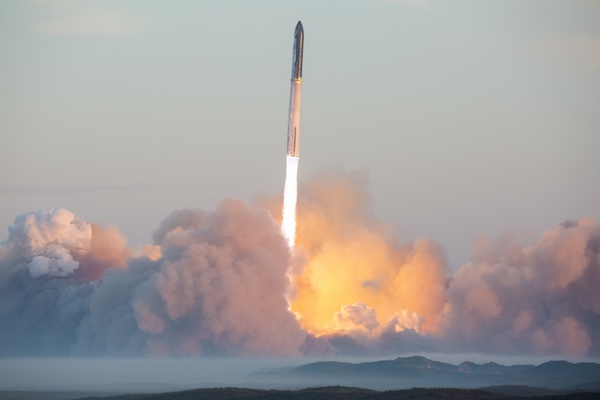 SpaceX’s Starship/Super Heavy vehicle lifts off on its second test flight November 18. (credit: SpaceX) SpaceX’s Starship/Super Heavy vehicle lifts off on its second test flight November 18. (credit: SpaceX) |
Starship flies again
by Jeff Foust
Monday, November 20, 2023

The plume had not yet dispersed from Saturday’s launch of SpaceX’s Starship/Super Heavy vehicle on its second test flight when the debates began about how to grade the outcome. Many hailed the launch as a success, demonstrating advances over the first flight seven months ago. Others argued it was a failure, as both the Super Heavy booster and Starship upper stage were destroyed, with Starship falling far short of the planned 90-minute flight that would have taken it to a splashdown near Hawaii.
Those debates, attempting to impose a binary success-or-failure criteria onto a more analog continuum of achievement, are not new: similar arguments erupted after the vehicle’s first flight in April (see “Grading on a suborbital curve”, The Space Review, April 24, 2023). What is clear that while SpaceX has made progress since that first flight, it’s less certain whether it’s moving swiftly enough both for the company and its biggest customer, NASA.
| What is clear that while SpaceX has made progress since that first flight, it’s less certain whether it’s moving swiftly enough both for the company and its biggest customer, NASA. |
One of the biggest signs of improvement was with Super Heavy. On the April launch, the booster suffered several failures of its Raptor engines, dooming the mission almost as soon as it lifted off the pad. SpaceX CEO Elon Musk said a couple months after that flight that the booster used a “hodgepodge” of older Raptors.
In a statement in September after the conclusion of a mishap investigation overseen by the FAA, SpaceX said that leaking propellant in the aft section of the booster created fires that severed connections with the primary flight computer. “This led to a loss of communications to the majority of booster engines and, ultimately, control of the vehicle.”
On this flight, by comparison, there were no apparently failures of the 33 Raptors in the Super Heavy booster. If there were any problems with those engines, they were not serious enough to affect the trajectory of the rocket.
A second major improvement was with the pad. The plume from those 33 Raptor engines tore up the concrete pad, sending debris up to ten kilometers from the pad, according to the US Fish and Wildlife Service (FWS). SpaceX acknowledged that it had underestimated the effects of the effects of the plume on the concrete without any kind of flame trench or deluge system based on static-fire tests at lower thrust levels that left the pad intact.
SpaceX installed a “steel sandwich” water deluge system at the repaired pad intended to prevent damage. That system, though, required an additional environmental review from FWS that held up the issuance of a revised launch license for the second launch. (The review concluded that the water from the deluge system “is expected to be less than an average summer rainfall event” and “would be unlikely to alter water quality.”)
That deluge system worked. Images of the pad showed no major damage after the launch. “Just inspected the Starship launch pad and it is in great condition!” Musk posted on X (formerly Twitter) on Sunday. “No refurbishment needed to the water-cooled steel plate for next launch.”
Other than the changes to the booster and pad to correct the problems seen in the first launch, the biggest change for Starship/Super Heavy’s second flight was a new stage separation system. Rather than a conventional approach of separating the stages and then igniting the upper stage engines—which never happened on the first flight because the vehicle failed before that point—SpaceX announced a change to a “hot staging” approach where the upper stage ignites its engines before separation. A new vented interstage section would allow the exhaust to escape during the few seconds between ignition and separation.
“This is the most risky thing, I think, for the next flight,” Musk said of the new stage separation approach in an online interview in June. The reason for doing so, he said, was to improve payload performance by avoiding losses from that brief coast during stage separation. “There’s a meaningful payload-to-orbit advantage with hot-staging that is conservatively about a 10% increase.”
| “There’s a meaningful payload-to-orbit advantage with hot-staging that is conservatively about a 10% increase,” Musk said in June. |
The staging itself appeared to work on flight two. The engines on Starship ignited and, a few seconds later, separated from the Super Heavy booster, a process that resulted in dramatic, almost ethereal images. Starship continued its ascent as Super Heavy started its return to Earth for a planned splashdown in the Gulf of Mexico.
However, about half a minute after separation, while performing a planned boostback maneuver, the booster suddenly broke apart, either on its own or after its flight termination system (FTS) was activated. SpaceX hasn’t provided additional information on the loss of Super Heavy, although the hosts of the SpaceX webcast stated that one thing they wanted to test on the flight was how the booster would handle the stresses from hot staging.
Starship continued its ascent, but about eight minutes after liftoff, not long before its engines were scheduled to shut down, SpaceX lost telemetry from the vehicle. It was traveling more than 24,000 kilometers per hour at an altitude of 148 kilometers at the time.
“We think we may have lost the second stage,” John Insprucker, principal integration engineer at SpaceX, said on the webcast. He later said that the FTS on Starship was triggered but didn’t indicate why it happened. SpaceX then ended the webcast and hasn’t provided an update on the test flight since then.
That meant that Starship didn’t complete the full flight profile, which like the first flight was to fly a “nearly orbital” trajectory that ended with a Starship reentry and splashdown in the Pacific Ocean near Hawaii 90 minutes after liftoff. However, the vehicle flew longer and achieved more milestones than the first flight, correctly the problems seen in the first one, while revealing new ones to be fixed.
Musk, in a post Sunday, said the booster and ship for the third launch “should be ready to fly in 3 to 4 weeks.” However, even if the vehicles and the pad are ready by then, the company will have to wait until it completes a mishap investigation and has it approved by the FAA. The updated launch license that SpaceX received from the FAA for the second flight was good for only a single flight, which means Starship can’t fly again until the FAA updates that license after the mishap investigation.
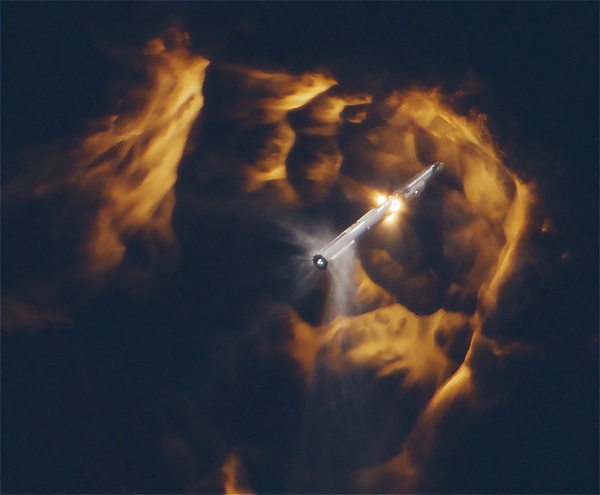 The Starship upper stage separates from the Super Heavy booster using “hot staging” on the November 18 launch. (credit: SpaceX) The Starship upper stage separates from the Super Heavy booster using “hot staging” on the November 18 launch. (credit: SpaceX) |
NASA concerns
Starship, of course, is essential to SpaceX’s future, from the deployment of a new generation of larger, more powerful Starlink satellites to its long-term ambitions for human missions to Mars. Starship, though, is also critical to NASA, which is counting on the lunar lander variant of Starship to return humans to the lunar surface on Artemis 3 in the middle of the decade.
NASA officials have, in the months since Starship’s first flight, have shown some frustration with SpaceX’s pace of development of Starship for the Human Landing System (HLS) program.
“They have a significant number of launches to go, and that, of course, gives me concern about the December of 2025 date” for Artemis 3, said Jim Free, NASA associate administrator for exploration systems development, at a June meeting of two National Academies committees. He later mentioned the “difficulties” SpaceX was having with Starship that concerned him about the schedule for Artemis 3. “You can think about that slipping probably into ’26.”
Asked about those comments at a NASA press conference two months later, Free suggested NASA might change the plans for Artemis 3 if Starship was delayed. “We may end up flying a different mission if that’s the case,” he said. “If we have these big slips out, we’ve looked at if can we do other missions.”
He said then he had received an “updated schedule” from SpaceX about its Starship HLS work, but didn’t disclose it, saying NASA need “some time to digest it.”
| “Yes, the lander is absolutely important,” Free said of Starship HLS development for Artemis 3. “But, we also can’t go anywhere without the suits.” |
Two and a half months later, NASA was still digesting that schedule. “What I’m really happy about is that they’ve shown us that end-to-end focus,” Free said at the American Astronautical Society’s von Braun Space Exploration Symposium in Huntsville, Alabama, October 25. He did not disclose details about that schedule and how it affected planning for Artemis 3.
At both that symposium and a meeting Friday of the NASA Advisory Council’s human exploration and operations committee, Free appeared to dial back the pressure on SpaceX to come through on Artemis 3. “We have a whole bunch of new stuff that comes together for [Artemis] 3,” he said at the committee meeting, including not just the HLS version of Starship but also modifications to Orion to allow for docking and new spacesuits under development by Axiom Space.
“Yes, the lander is absolutely important,” Free said. “We can’t go anywhere without it. But, we also can’t go anywhere without the suits.”
Even a fully successful Starship test flight, though, would be only the beginning of SpaceX’s development efforts for a lunar lander. The company then needs to demonstrate cryogenic propellant transfer in orbit and the ability to launch Starships on a regular, rapid cadence to fill up a propellant tank in low Earth orbit that would then fuel the lunar lander Starship for its mission to the Moon.
At Friday’s committee meeting, Lakiesha Hawkins, assistant deputy associate administrator in NASA’s Moon to Mars Program Office, said the agency expected the total number of launches for each Starship HLS missions to be “in the high teens”, far higher than what SpaceX has previously stated. Musk, back in 2021, said he believed no more than eight launches of tanker Starships would be required, and could be as little as four.
Those launches, she said, would take place on a “six-day rotation” involving both the Starbase launch site at Boca Chica as well as a new Starship launch pad SpaceX is building at Kennedy Space Center’s Launch Complex 39A. While SpaceX has shown the ability to launch Falcon 9 rocket’s frequently—it carried out two such launches over the weekend just before and after the Starship launch—that cadence came after only many years of work by SpaceX. Artemis 3 is currently a little more than two years away.
Free, at the Huntsville conference, said he was looking ahead to the upcoming Starship test flight, sometimes designated OFT-2 for Orbital Flight Test 2. “We need OFT 2 to go, so I hope everybody in this room is cheering on OFT-2,” he said. “We need that to be successful to get us that much further down the road.”
But, like those debates from armchair analysts online after Saturday’s launch, he did not define what he considered it meant for the launch to be “successful.” In a social media post after the launch, he wrote, “Looking forward to seeing what can be learned from this test that moves us closer to the next milestone.”
Jeff Foust (jeff@thespacereview.com) is the editor and publisher of The Space Review, and a senior staff writer with SpaceNews. He also operates the Spacetoday.net web site. Views and opinions expressed in this article are those of the author alone.
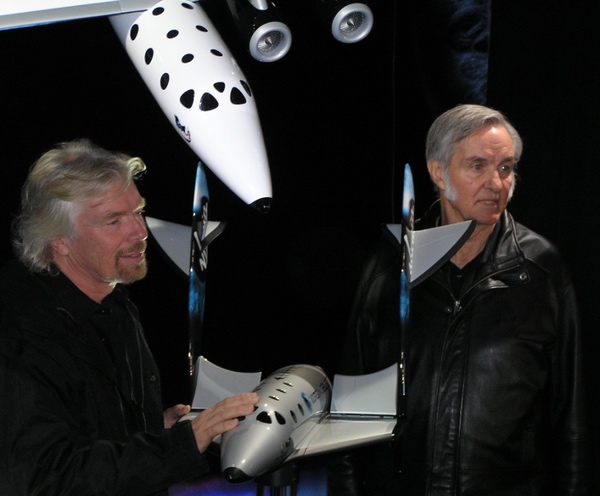 Burt Rutan and Richard Branson unveiling the initial design for Virgin Galactic’s suborbital spaceship, 2008. (credit: Virgin Galactic)My suborbital life, part 10: Looking Up, WAY Upby Alan Stern
Burt Rutan and Richard Branson unveiling the initial design for Virgin Galactic’s suborbital spaceship, 2008. (credit: Virgin Galactic)My suborbital life, part 10: Looking Up, WAY Upby Alan Stern Receiving Virgin Galactic astronaut wings with my fellow Galactic 05 first-time space flyers Ketty Maisonrouge and Kellie Gerardi, the evening after our flight, nicknamed “High 5.” (credit: Virgin Galactic)I learned a lot in making that flight. And from those lessons learned, I see now how to better use the new generation of commercial suborbital vehicles to advance research and education, how to better train for future spaceflights, how to better conduct future suborbital spaceflights, and how to pay forward my good fortune by passing along the many lessons learned to help others be successful in their spaceflights, whether they are as workers on their flights, like myself, or tourists.I intend to fly in space many more times, and not just suborbitally, but also hopefully in Earth orbit, and maybe (just maybe) even beyond.And I believe humankind’s “Star Trek” future will not only be achieved, but will ultimately be traced back to the 2020s when spaceflight became so much less rare than it had been.Among the advances of the 2020s that make the pivot to a far-off Star Trek future so obvious are:The true dawn of reusable spacecraft and launch vehicles.The opening of space access to such a broader and more democratized range of people than ever before.The development of business models that create much faster development of space capabilities fueled by private capital infusion.And new scientific discoveries that promise to give birth to new use cases for space.I intend to fly in space many more times, and not just suborbitally, but also hopefully in Earth orbit, and maybe (just maybe) even beyond.I owe a great deal of thanks to many people and institutions that made my first spaceflight possible, including, my two amazing parents, many talented and inspiring teachers, astronauts at the dawn of the space age who were such strong role models to me, space scientists and engineers, NASA, my farsighted employer the Southwest Research Institute, my crew mates on Galactic 05, my space science colleagues, and the commercial spaceflight industry.I intend to redouble my efforts contribute to the development of space, and to inspire children and adults alike to further accelerate the commercial spaceflight revolution and its shining promise of a better tomorrow.
Receiving Virgin Galactic astronaut wings with my fellow Galactic 05 first-time space flyers Ketty Maisonrouge and Kellie Gerardi, the evening after our flight, nicknamed “High 5.” (credit: Virgin Galactic)I learned a lot in making that flight. And from those lessons learned, I see now how to better use the new generation of commercial suborbital vehicles to advance research and education, how to better train for future spaceflights, how to better conduct future suborbital spaceflights, and how to pay forward my good fortune by passing along the many lessons learned to help others be successful in their spaceflights, whether they are as workers on their flights, like myself, or tourists.I intend to fly in space many more times, and not just suborbitally, but also hopefully in Earth orbit, and maybe (just maybe) even beyond.And I believe humankind’s “Star Trek” future will not only be achieved, but will ultimately be traced back to the 2020s when spaceflight became so much less rare than it had been.Among the advances of the 2020s that make the pivot to a far-off Star Trek future so obvious are:The true dawn of reusable spacecraft and launch vehicles.The opening of space access to such a broader and more democratized range of people than ever before.The development of business models that create much faster development of space capabilities fueled by private capital infusion.And new scientific discoveries that promise to give birth to new use cases for space.I intend to fly in space many more times, and not just suborbitally, but also hopefully in Earth orbit, and maybe (just maybe) even beyond.I owe a great deal of thanks to many people and institutions that made my first spaceflight possible, including, my two amazing parents, many talented and inspiring teachers, astronauts at the dawn of the space age who were such strong role models to me, space scientists and engineers, NASA, my farsighted employer the Southwest Research Institute, my crew mates on Galactic 05, my space science colleagues, and the commercial spaceflight industry.I intend to redouble my efforts contribute to the development of space, and to inspire children and adults alike to further accelerate the commercial spaceflight revolution and its shining promise of a better tomorrow. Star Trek: A Faith of the Heart (credit: Where My Heart Will Take Me).This blog is my tenth and final one in a series that I’ve written around my flying aboard the Galactic 05 space mission. Thank you for coming along on my first journey off the shoreline that is Earth’s surface and into the ocean of space that begins just 50 miles over all our heads.I’ll close now with these brief excerpted lyrics from the Star Trek Enterprise theme song, “Faith of the Heart.” I hope this serves as an inspiration to all of you who dream of spaceflight:I’m going where my heart will take me
Star Trek: A Faith of the Heart (credit: Where My Heart Will Take Me).This blog is my tenth and final one in a series that I’ve written around my flying aboard the Galactic 05 space mission. Thank you for coming along on my first journey off the shoreline that is Earth’s surface and into the ocean of space that begins just 50 miles over all our heads.I’ll close now with these brief excerpted lyrics from the Star Trek Enterprise theme song, “Faith of the Heart.” I hope this serves as an inspiration to all of you who dream of spaceflight:I’m going where my heart will take me